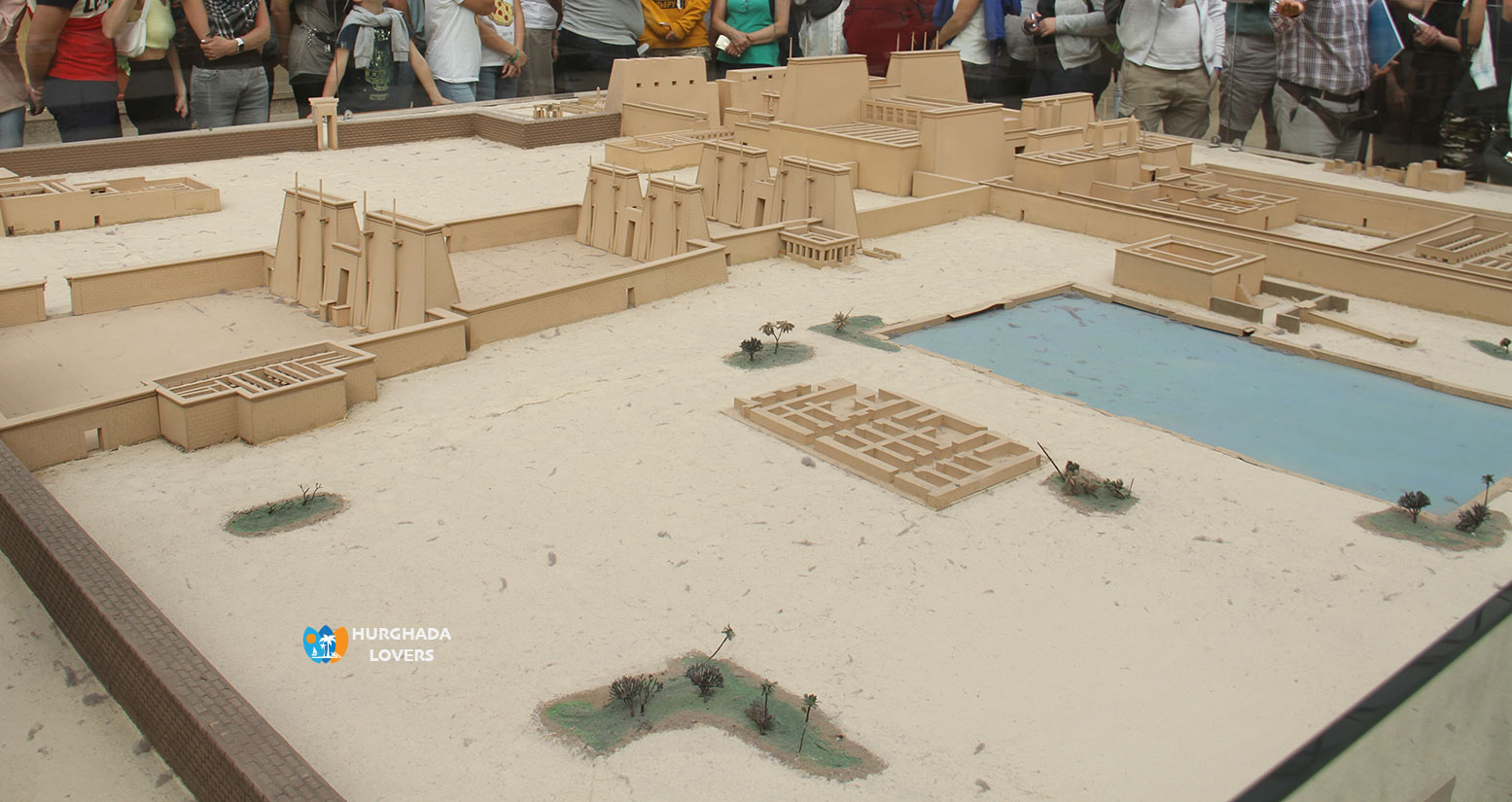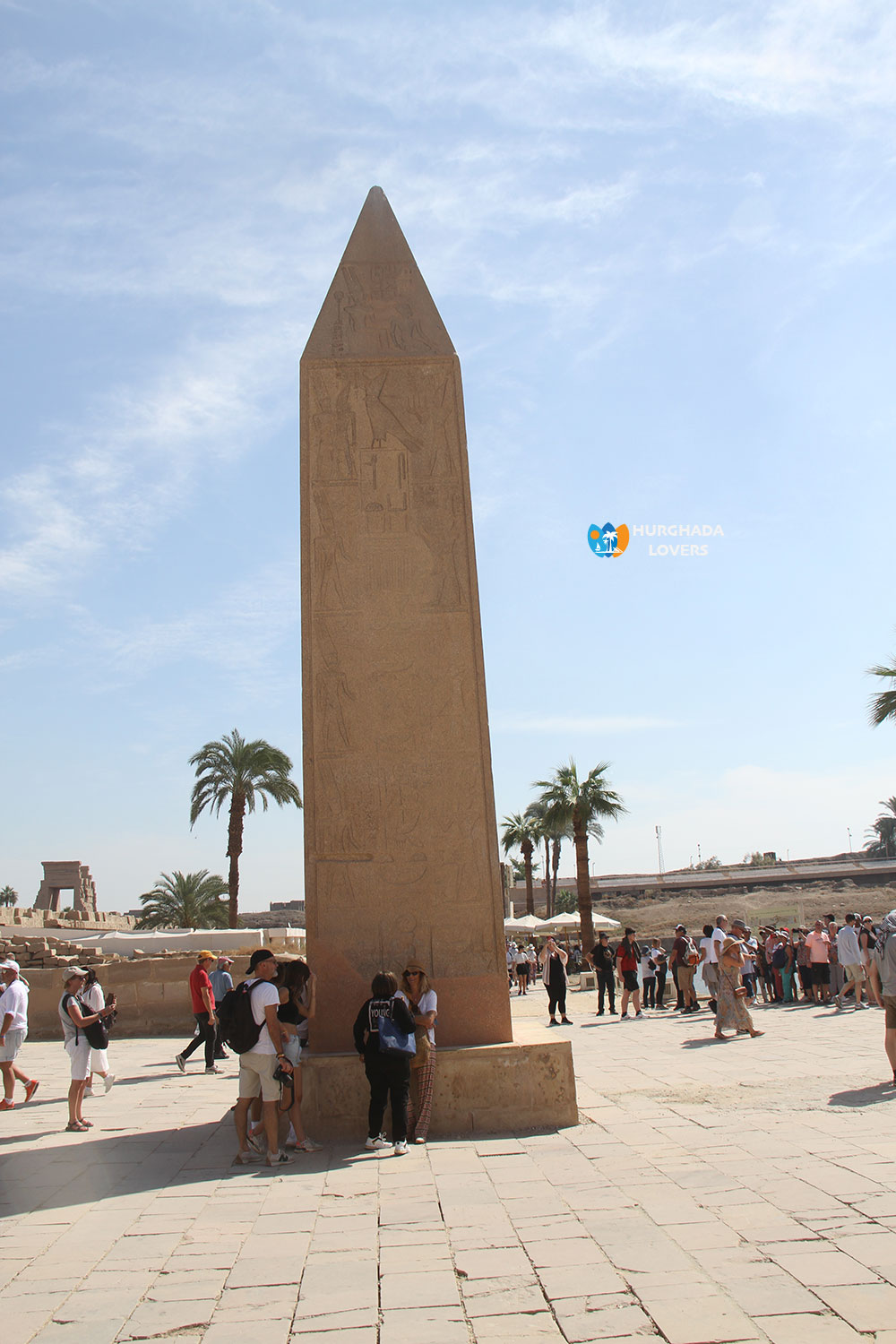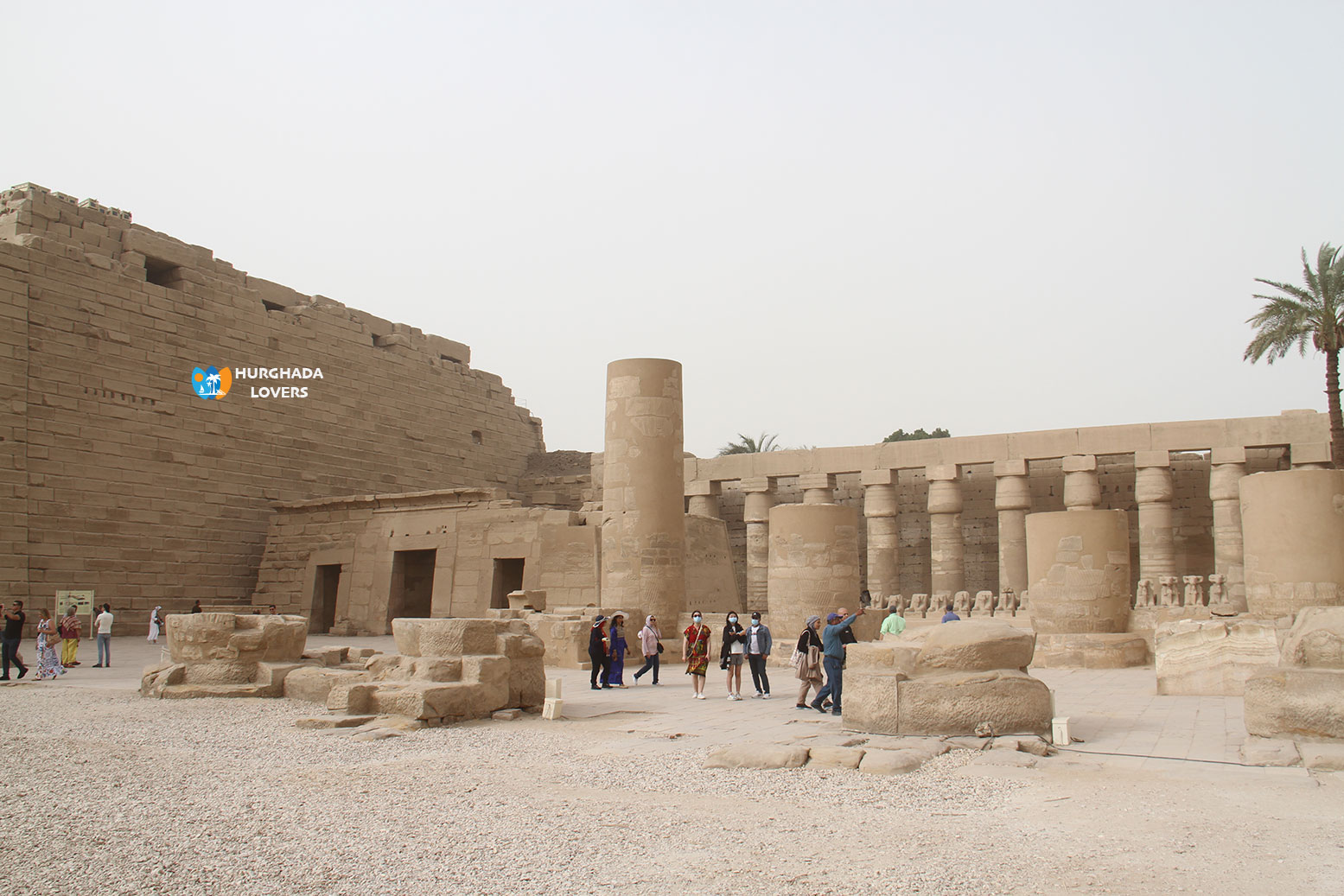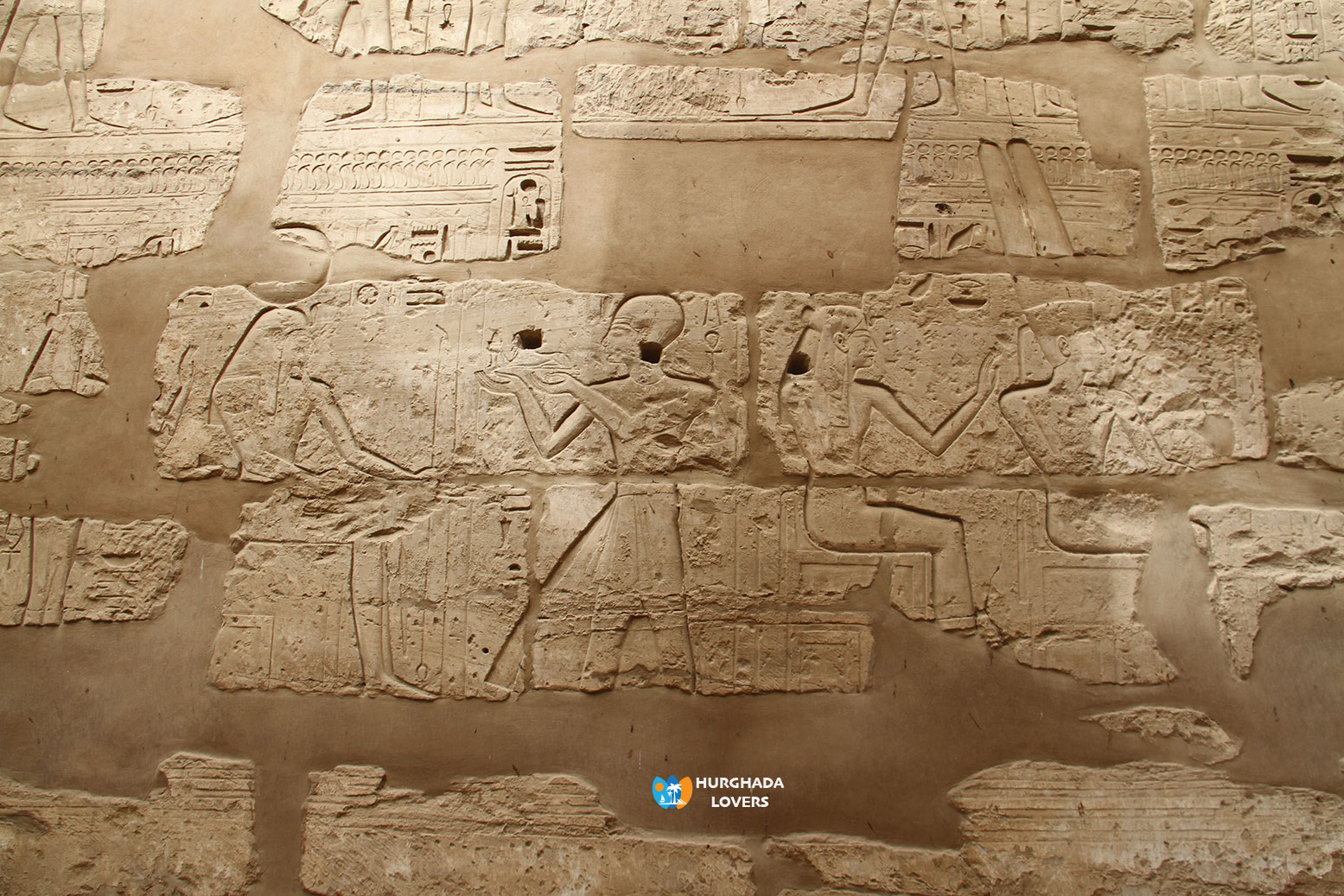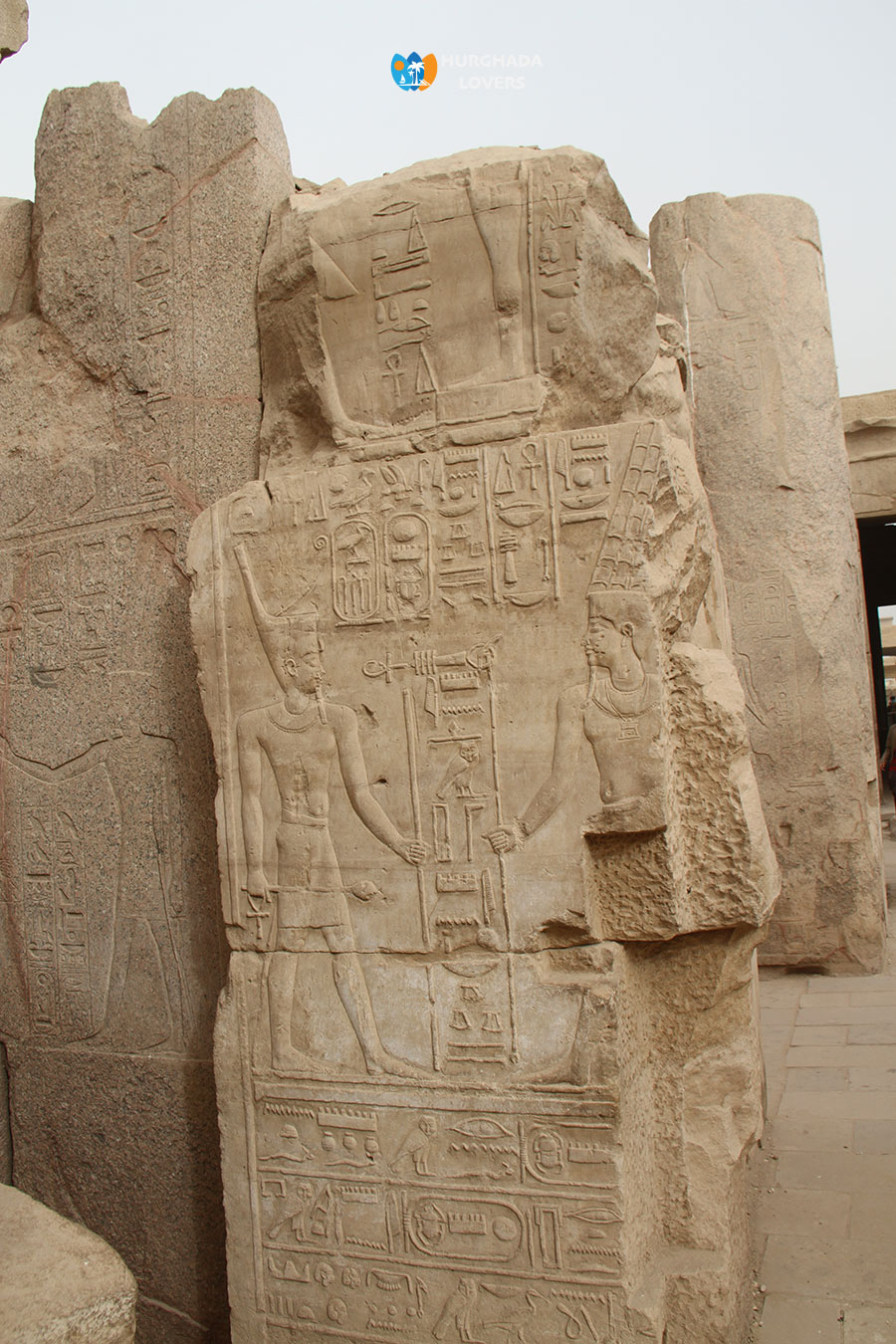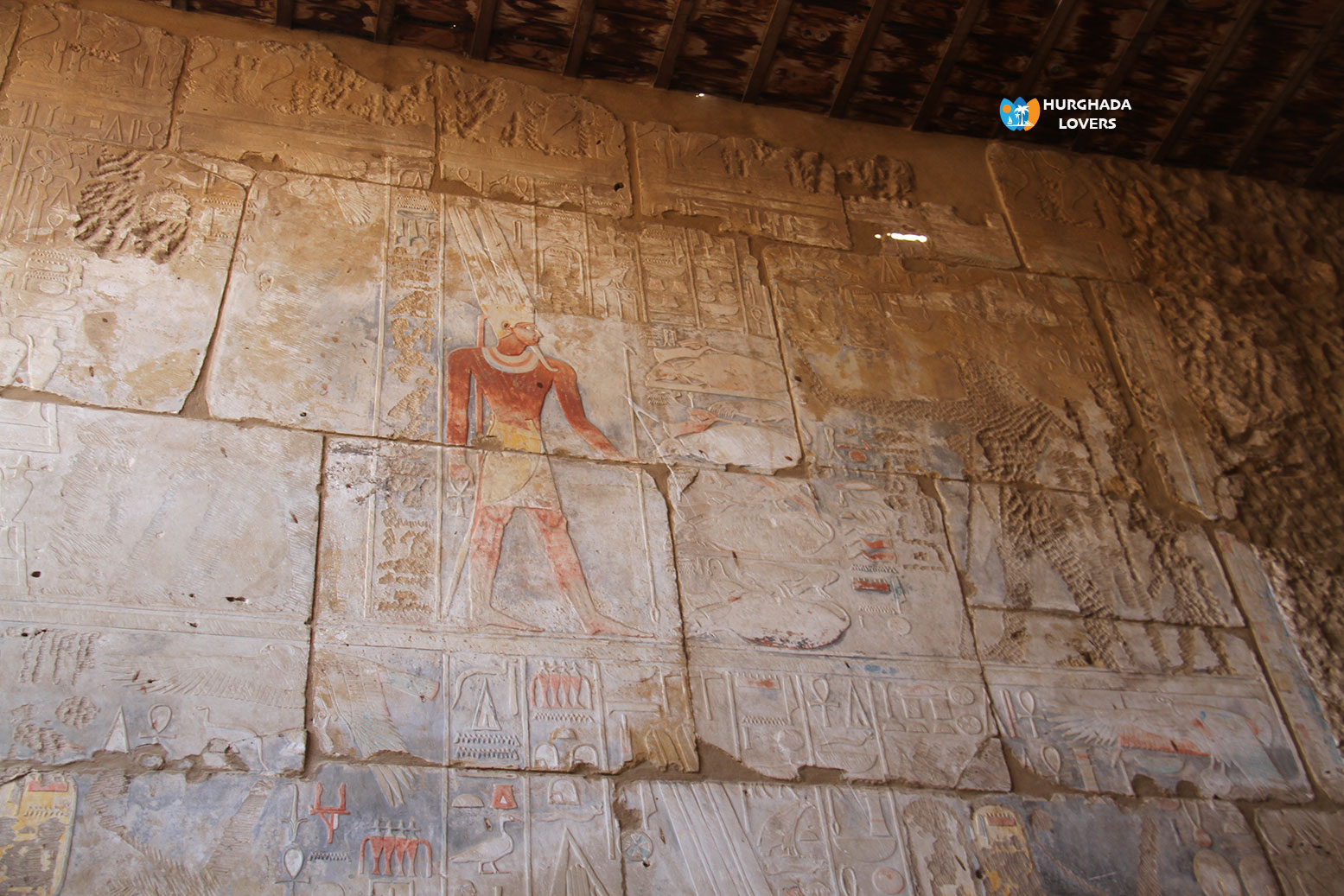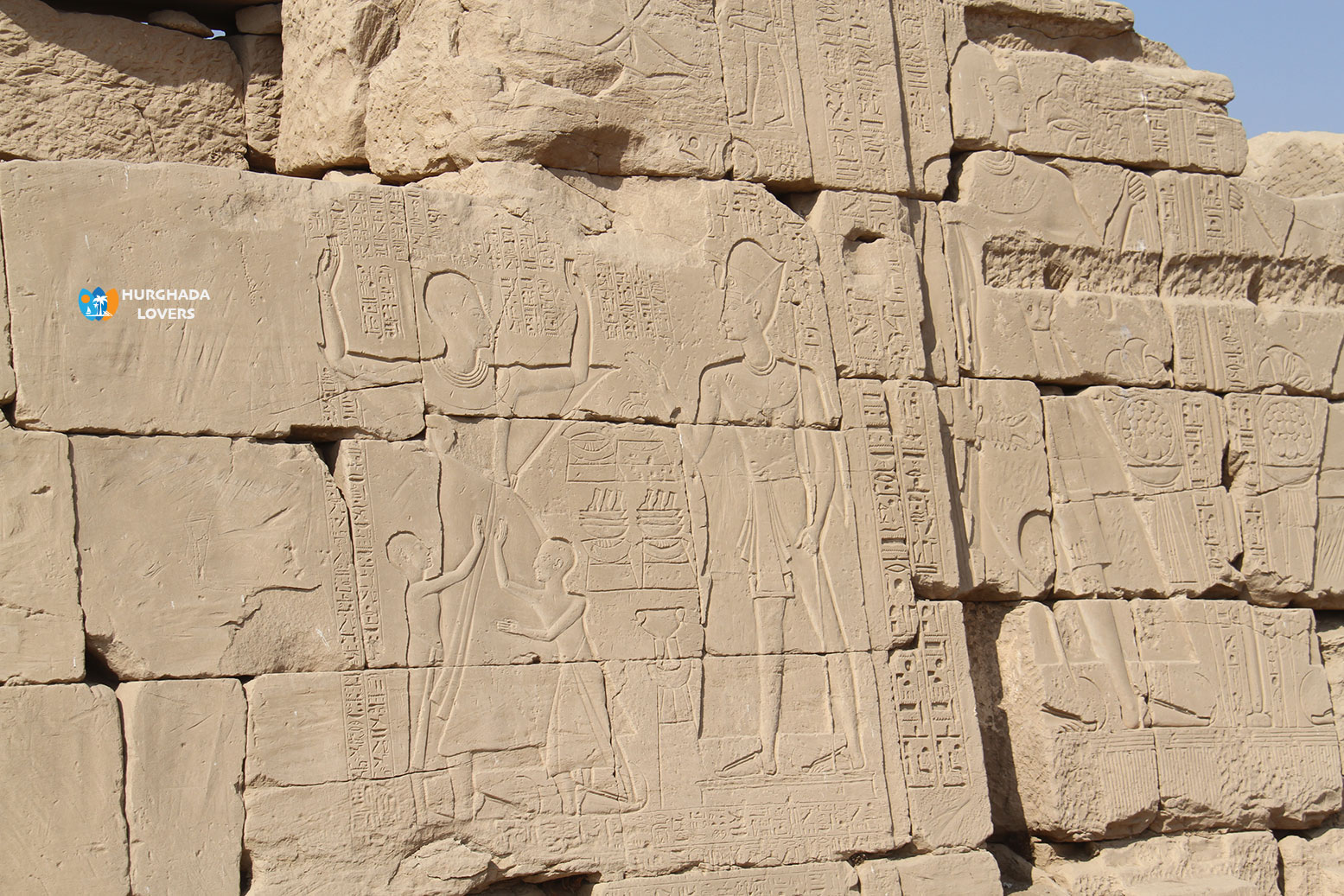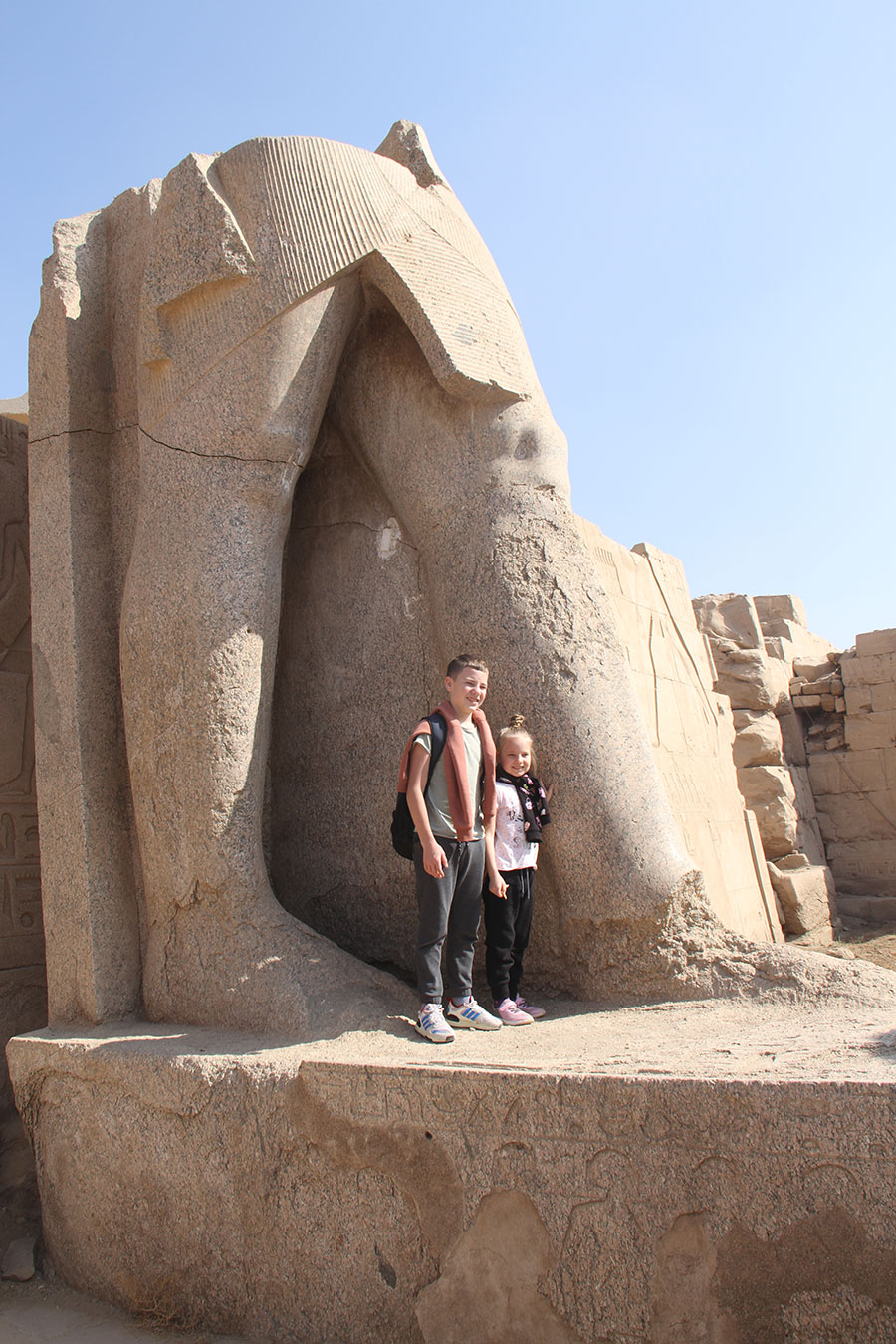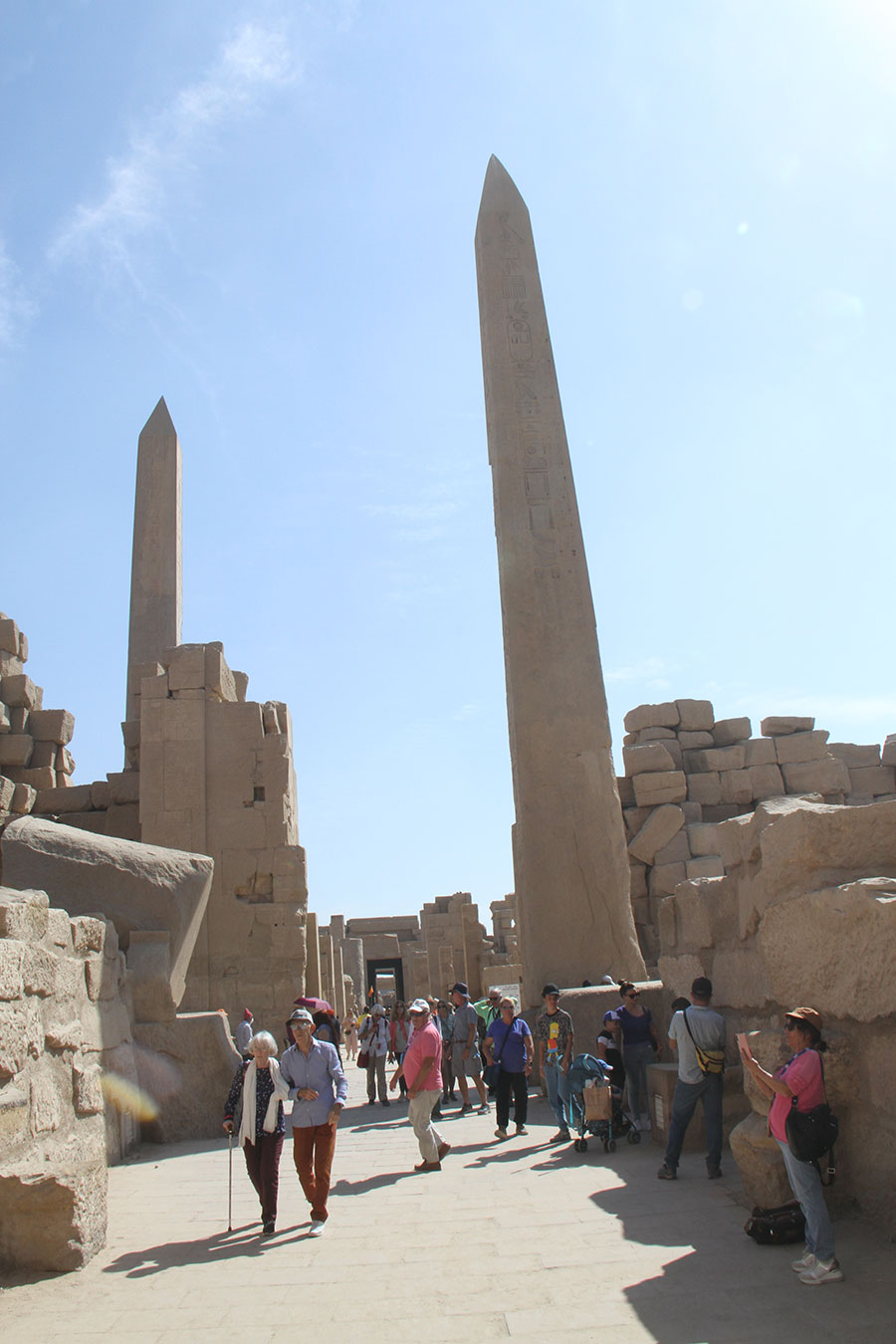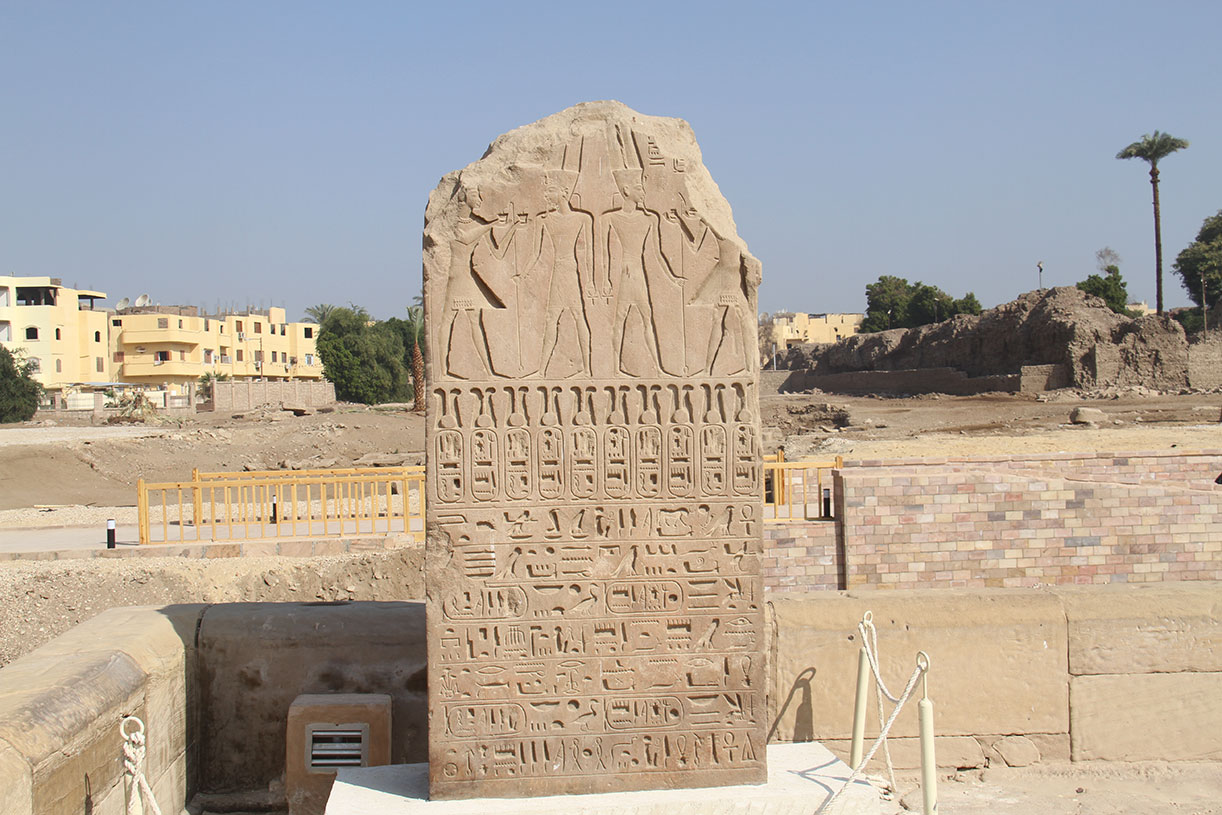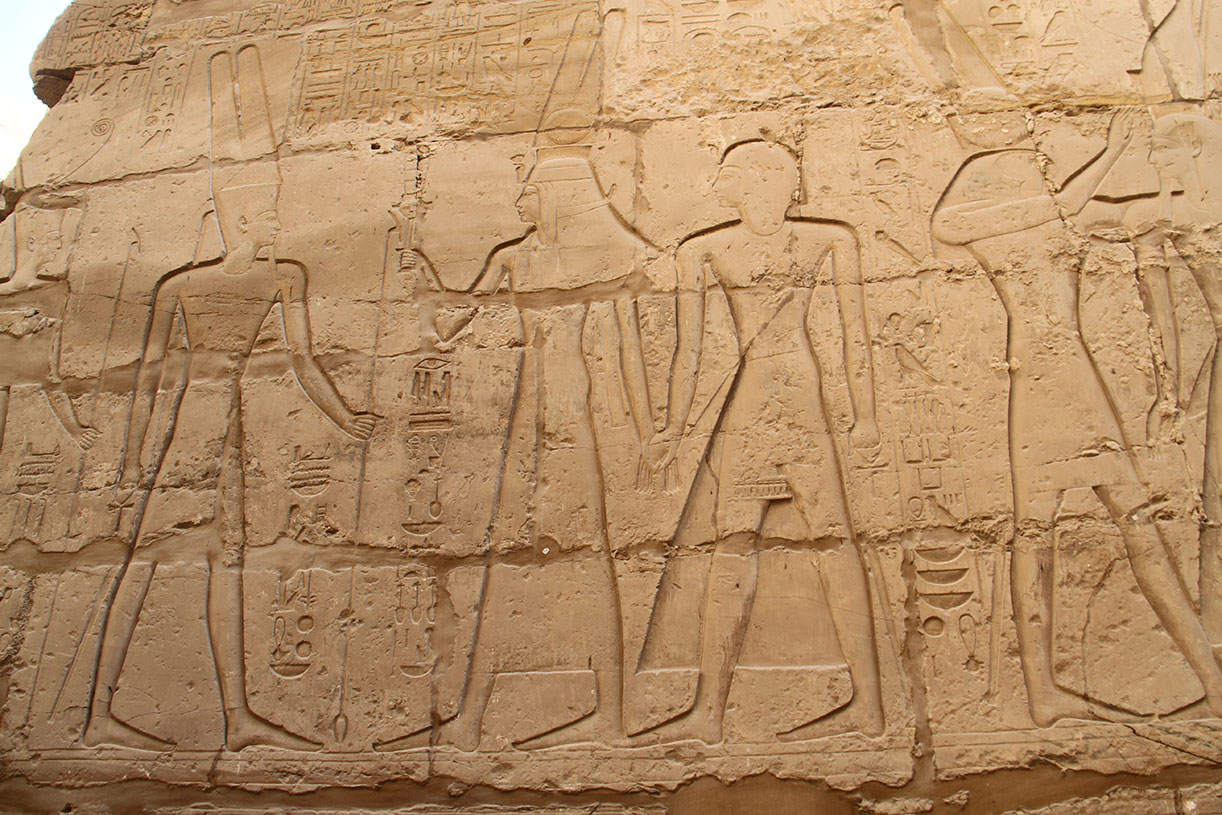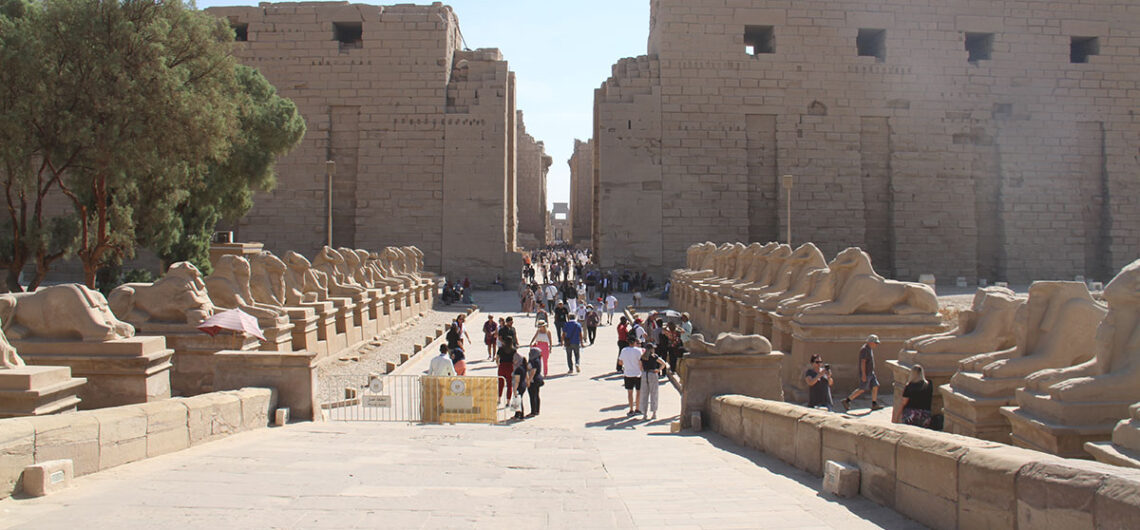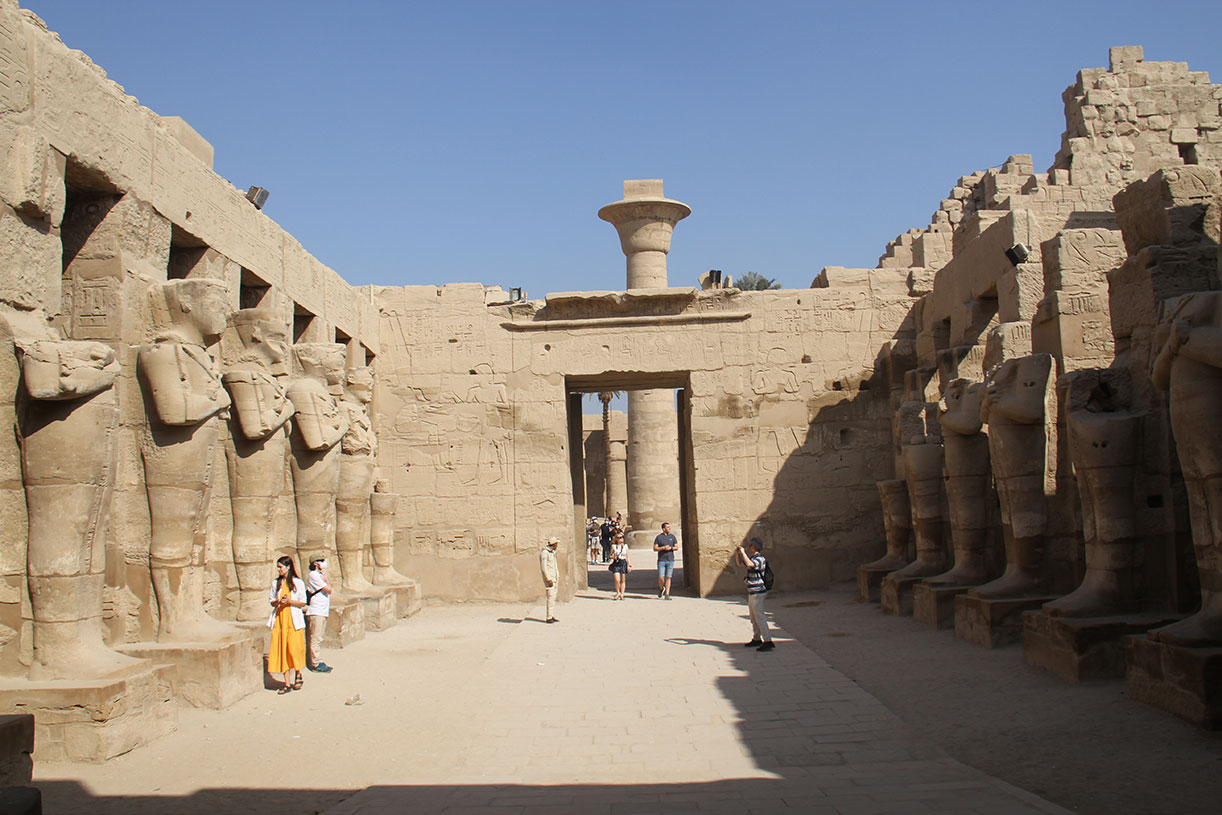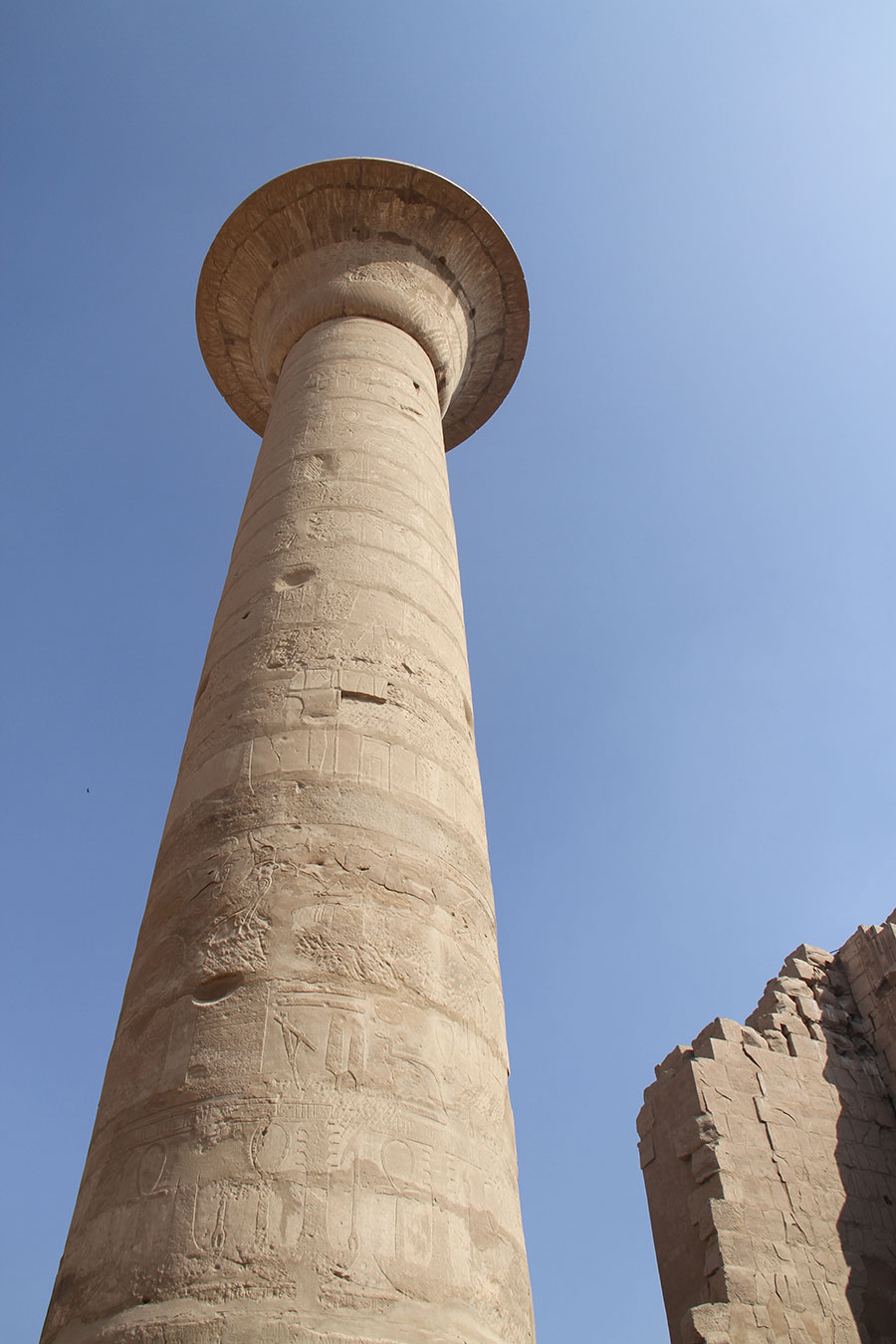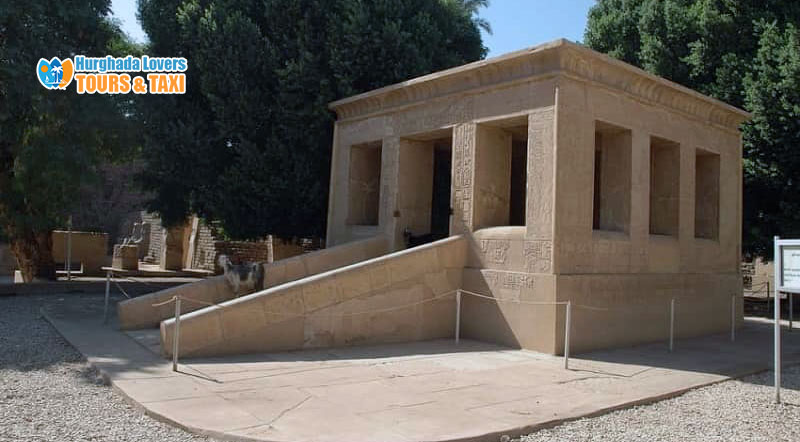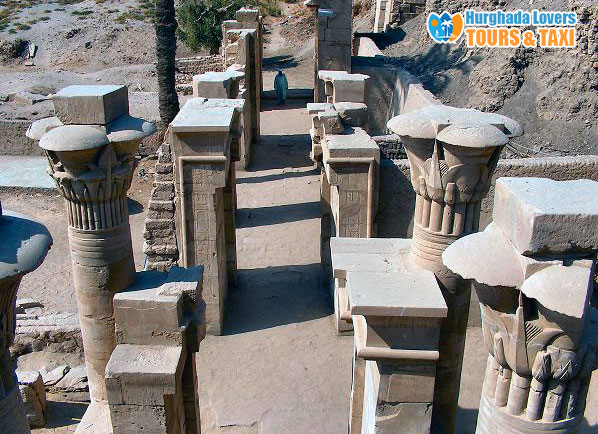Karnak Temple in Luxor, Egypt | Facts, History, Map, Photos, Discover Secrets Who built & Temple of Amun-Re, Architecture, Definition Informations, Entrance fee, Opening Hours and more about Ancient Egypt History.
Facts about the largest Pharaonic Egyptian Temples in the civilization of Ancient Egypt, what are the Pharaonic Egyptian Monuments and funerary Mortuary Temples inside to tell us the history of Pharaohs, the most important Egyptian Pharaohs kings and Female Pharaohs who contributed to building the temple to worship the ancient Egyptian deities,
Note: there Tips below the article. How to start your trip and visit the Karnak Temple Complex and more about the most famous Egypt Archaeological Sites.
Karnak Temple Facts
- It is considered one of the ritual temples that he used Egyptian Pharaohs kings as in Ancient Egyptian religion.
- Karnak Temple is located on a large area, covering about 200 acres, and has been a place of pilgrimage for almost 2,000 years..
- The Karnak temple complex contains 4 small temples No more important and more famous Religious beliefs of the Pharaohs It is a temple God Mut And a temple God Ptah And a temple God Khonsu and Temple of King Ramses III from the Twentieth Egyptian Dynasty during The New Kingdom period, known as The Ramesside Period. It has the Tomb of King Ramesses III | KV11 in Valley of the Kings..
- The Temple of Amun area has been added to the organization UNESCO and World Heritage Sites in Egypt the year 1979 AD.
- Karnak Temple has the tallest and largest temple Obelisks of the Pharaohs to Queen Hatshepsut, from the Eighteenth Dynasty of Egypt, has the Mortuary Temple of Hatshepsut in Deir El Bahari who building by Senenmut, Mount Qurna, Thebes..
- It contains the largest closed lake in Egypt, which is the sacred lake that has baffled the world. Until now, it has not been explained whether the water level has lost or dried up, “It is truly a Pharaonic miracle”, It indicates the development of Ancient Egyptian science.
- The Karnak Temple contains two axes with one line, which is the sun axis and the axis The Nile River.

Who built the Karnak Temple?
It was built during the era of King Senusret I, The most important kings Middle Kingdom from Twelfth Dynasty of Egypt Pharaonic.
Period: Middle Kingdom until Ptolemaic Kingdom.
Plan of the Karnak Temple Complex / Map of the Great Temple of Amun Ra from the inside:
Through the article, I explain to you with Photos all the temples, views, and Pharaonic inscriptions present in the Karnak Temple Complex, in detail, step by step, to begin your Tour to discover the Sculpture in Ancient Egypt, History of the Architecture in ancient Egypt And secrets that you did not know before.
In addition, you will find links to all kings, gods and religious beliefs through explanation and go to them through my blog to discover and acquire really new information about the civilization of ancient Egypt.
Entry Hall Karnak Temple
The main hall of the Karnak entrance contains the following:
- A model of the Karnak Temple and its accessories.
- Royal ships that were used in Pharaonic Festivals in Ancient Egypt as in Coronation of the Pharaohs.
- Archive photos on the walls show what the temple looks like from above and the stages of its development over the years.
- Places for bathrooms and entry ticket counters.
- A spacious garden directs you to the entrance to the temple.
- Security and guard room for inspection.
Reception Courtyard
There is still a canal connected to the Nile River at the entrance to the Karnak Temple, where stones “Ancient Egyptian Metallurgy” were transported by wooden boats along the Nile River and reached the port of Karnak..
Port
Two small Obelisk of Seti II
The obelisk was built Pharaonic sand stone, It is 250 cm high on the north east side of the entrance and the second is on the south east side and contains inscriptions and texts for the names King Seti II And texts Ancient Egyptian Language To give as a gift to God Amun.
Rams Road-Sphinx Street – Avenue of Sphinxes:
- It is 52 meters long and 13 meters wide.
- The Karnak temple complex contains 3 ram roads, known as Street Sphinx, where the first connects Luxor Temple to Karnak is 3 km long, the second is at the entrance, and most of the statues were demolished and previously restored Egyptian Ministry of Tourism and Antiquities The third connects the Temple of Amun and the Temple of Mut.
- The road was built during the era King Nectanebo I from Thirtieth Dynasty Pharaonic, It connects the Temple of Khonsu, south of the Karnak Temple, with the Temple of Luxor. It is a road paved with stone floors and on both sides are 34 stone statues in the shape of the famous Sphinx Such as the one in The Pyramids of Giza area in Cairo.
- There are explanations from Egyptology that confirm that road The Sphinx replaced the old attributed Rams Road to King Amenhotep III “Amenophis III” from Eighteenth Dynasty Pharaonic and era The New Kingdom Where the king painted his name on the southern gate of the Temple of Khonsu.
- The statues were built and designed in a distinctive and unique artistic style to tell us secrets Social Structure in Ancient Egypt & Industry in ancient Egypt ,Where the engineers made a single block of sand stone for Ras As ad to King Nectanebo I Then the statue is installed on a rectangular base, and the road is considered a path for the official royal or divine procession.
- The ram symbolizes the protection of the temple. In addition, we find a statue under the ram’s chin representing the god Amun God Ra, and the rams bear the name King Ramses II from Nineteenth Dynasty of Egypt, It was carved and added during the era of the Pharaonic king.
First Pylon Karnak Temple:
- The First Pylon is 113 meters long, 40 meters high, and 15 meters thick.
- It was built in the era King Nectanebo I From the thirtieth Pharaonic dynasty.
- The height of the first tower at the entrance to Karnak Temple is 31 metres, and the second tower is 21 metres. It contains spaces for adding flags during celebrations..
First Courtyard:
- After the first tower, we find a large open courtyard with an area of 100*85 metres.
- The courtyard was built in the era King Shoshenq I from Twenty-second Dynasty of Egypt in Third Intermediate Period of Egypt.
- Behind the row of rams we find a colonnade of columns named after kings Tell-Basta From the 22nd Dynasty of Libya, which was a city Al-Sharkia Its capital on Delta area.
- On the right is a full row of Number 33 Statues of rams On the southern side and 19 statues on the northern side, Which extended along the path of the Sphinx rams on both sides until the beginning of the second Pylon, This row of rams was moved to its current place after the construction of the First Pylon by ancient Egyptian workers.
- There were plant beds “Agriculture in Ancient Egypt” connected to pottery pipes in a wonderful geometric shape.
Barque Shrine of Seti II
- Located Number 3 Cabins From lime stone On the left side of the main temple entrance “The shrine of the god Mut, the eastern shrine of the god Khonsu, the middle shrine of the god Amun.”.
- The shrines were built for the resting place of the sacred boats to the god Amun Ra at the end of the annual Opet Festival.
- It contains scenes of King Seti II “He has Tomb of King Sethi I | KV17 among the Pharaonic royal Egyptian Tombs in the Valley of the Kings” making sacrifices to the Thebes Triad.
Temple of King Ramesses III
- The temple is located on the right side of the temple as you enter from the main entrance.
- The area of the temple is 52 square metres.
- The temple was created to worship a trinity Thebes in addition to building a resting place for the Pharaonic sacred boats after the end of his Opet Festival from the Luxor Temple, the resting place in his temple becomes the place of the palaces of King Seti II, and he obtains a blessing for the legitimacy of his rule for the throne Egypt.
- It is considered one of the best architectural examples of the Pharaonic New Kingdom era for the worship of the gods and religious beliefs of the ancient Egyptians.
- The construction of the Temple of King Ramses III in Karnak began immediately after the completion of the construction of the King’s Temple in the Medinet Habu In the West Bank of Thebes, with the same scenes on the walls, but now they have lost their colors and quality.
- Another temple of King Ramesses III was discovered in the northern area of the Karnak temple complex.
- The temple was built before the first Pylon, and King Ramses III did not know that several shrines and buildings would be built next to it to join the area of the Temple of Amun Ra.
Temple of King Ramesses III from the inside & Map:
The First Pylon – the Facade of the temple:
In front of the entrance stand two Sandstone statues on two bases of King Ramesses III wearing the double royal crown over his headdress, “a tradition created by the Pharaonic king that is unique to him only among kings.”
On either side of the first Pylon of the Temple of King Ramesses III, we find a gallery of Basin columns, which were built after the temple was completely built.
The walls of the eastern façade contain scenes representing King Ramesses III with the double crown “to express the legitimacy of his kingship over the regions of Lower and Upper Egypt together as in Geography of ancient Egypt” as he eliminates his enemies with the “military suppressor” stick and he holds the enemies’ hair in the presence of the god Amun giving him the sword in his right hand.
It indicates the development and strength of the Military of ancient Egypt and how interest there was in games and Ancient Egyptian Sport.
In his left hand we find him holding three Ropes tied to prisoners of war with Nubia With the sign of life “Ankh”, above the double crown of the king we find the God Nekhbet to protect it and behind it we find texts in the language Hieroglyphs The Pharaonic king’s royal titles.
The walls of the western façade contain scenes of King Ramesses III wearing the red crown “to express the legitimacy of his kingship over Lower Egypt,” with the same design as the corresponding scene, with the difference that the god Amun holds four ropes holding prisoners of war on the continent of Asia.
In the shadow of the entrance door, there is a view on the right of the Pharaonic king with the god Amun and a group of writings and texts in the ancient Egyptian language of royal titles.
We find scenes on the walls. On the right, we find a drawing of the god Ptah Over looking the courtyard of Karnak Temple.
Open Courtyard:
On the lintel of the entrance from above, there are similar drawings and scenes. At the top, in the far north, we find the Pharaonic king offering wine “Food in ancient Egypt” to the god Amun Min, then a view of a king offering the symbol of justice and Law in Ancient Egypt to the God Maat Sitting behind him is the god Khonsu.
The lintel walls contain double scenes in which the inscription of the king offering wine to Amun and offering lettuce to the god is painted God Min He then offers the symbol of justice to the god Min.
The gate is surmounted by the Egyptian Pharaonic Corniche, then from behind the walls of the facade of the temple from the inside, we find views from the left side of King Ramesses III with the Pharaonic royal insignia, which is the head of the snake and the hunting tool, presenting himself to the god Amun holding the scepter of rule and control and the sign of life “Ankh” to take
In addition to receiving 3 signs for celebrations and jubilee holidays. The golden statue of the king, in addition to inscriptions and writings of the period of the king’s reign on the throne of Egypt as in Clothing in ancient Egypt, and above it is the symbol of the God Sekhmet then below are 4 forms of God Hapi “The symbol of the Nile” to indicate the northern regions of Egypt, including the city Memphis He offers sacrifices to the god Amun, and on the other side, the same view of the king, with the difference in the 4 regions of Egypt in the south, including the city of Thebes.
There are 16 statues of King Ramesses III in the courtyard on both sides, 8 statues per row Oziria.
Eastern Corridor:
The portico consists of 4 columns, where the floor level of the portico is higher than the level of the roof of the courtyard.
Scene of the celebration of the Feast of Amun
The inscription is located on the walls of the eastern side and begins with 4 separate scenes, which are small boats of the Theban Triad, the sacred boat of King Ramesses carried by the priests of the temple, then a view of the boat of the god Amun, carried by the priests and led by King Ramesses III.
It was discovered that this boat is 86 meters long and was restored in the era of King Ramesses III for use. In annual celebrations as in Ancient Egyptian Literature.
Then the king sings in his second year, offering incense and talking about his achievements during his reign in Ancient Egyptian Government. Then the king follows him, offering incense and wine to the Theban trinity.
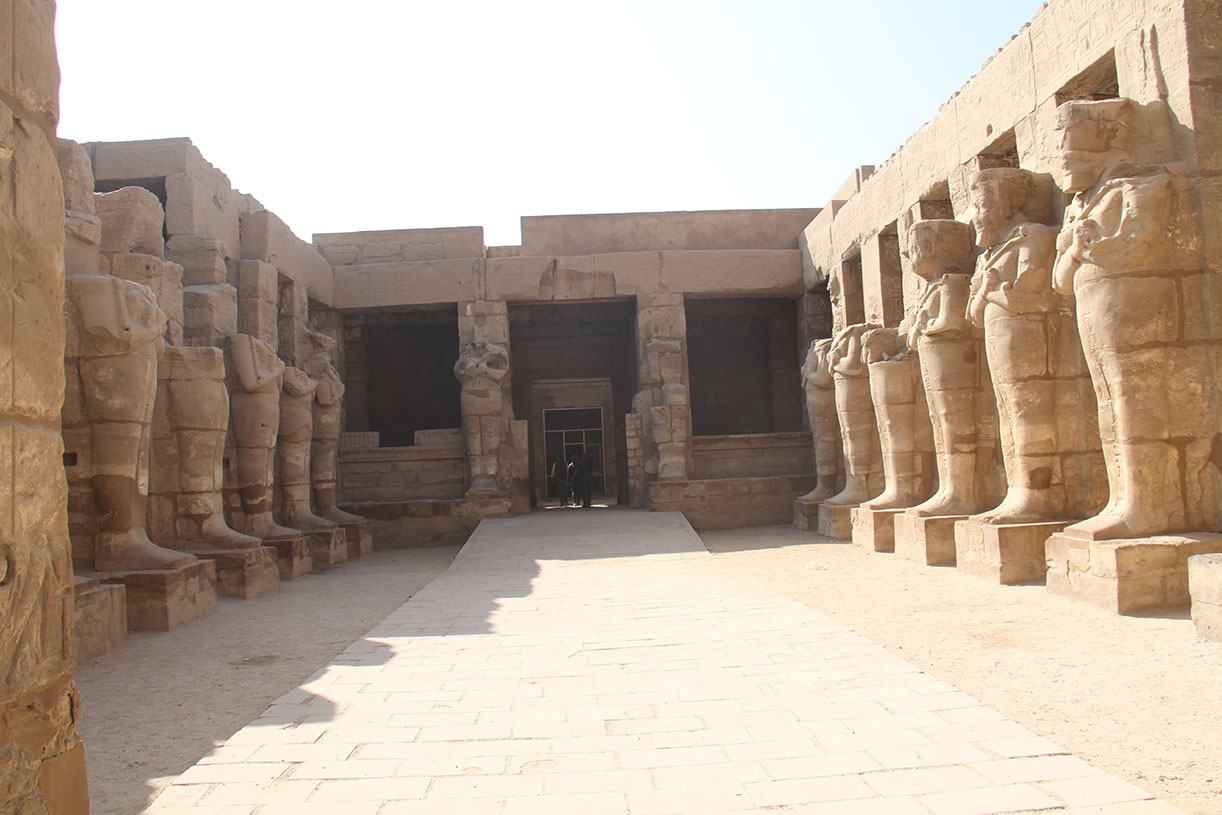
Western corridor:
The scene of the feast of the deity Min – the scene of the priests masturbating
The drawing begins with the princes carrying fans, then the servants carrying pottery vessels, then at the top is the god Sekhmet with priests carrying emblems of protection, then King Ramesses III releases incense on the sacred boat carrying the idol Min, and in front of him is a group of priests carrying fans and lettuce plants to circumambulate the god Min in the Karnak Temple.
The third scene shows King Ramesses III offering sacrifices to the god of Amun-Ra, Kamut-F, a symbol of fertility and an aphrodisiac for the Pharaohs in the form of “a shrouded body with his arm and erect penis emerging from it,” and a group of lettuce and priests and High Priest of Amun bowing to him and offering sacrifices to him.
The fourth scene shows King Ramesses III holding the scepter of Sokhna and the God Thoth, his name is recorded as the king and the jubilee, and he offers sacrifices to the Theban trinity, where the Scepter of Sokhna was discovered among the treasures King Tutankhamun, Which was discovered from the Tomb of Tutankhamun | KV62 in the Valley of the Kings by the English archaeologist Howard Carter and is now displayed in the Grand Egyptian Museum “Museums in Cairo”.
At the entrances to the portico, we find scenes of the king offering bread to the god Mut, a group of inscriptions of royal titles, and the other end is a scene of the king offering sacrifices to the god Min and the god Khonsu.
Terrace:
It begins with walls that are half the height of the columns to hide the religious rituals that take place inside from the common people in the outer courtyard. It contains 4 curtains containing scenes and Pharaonic inscriptions of a king with the Theban Trinity and a group of gods and religious beliefs of the ancient Egyptian Pharaohs, but they are currently damaged and unclear.
On the back side of the terrace walls we find scenes of the king with the God Wadjet, “the symbol of the north,” offering wine and wine to the goddesses Amun and Khonsu, then a scene burning incense and offering wine to the goddess Mut and Amun, and the third scene with the goddess Nekhbet, “the goddess of the south,” offering bread to the goddess Mut and Amun.
Inside the terrace we find 4 columns. One column contains a scene of King Ramesses III making offerings to the ancient Egyptian goddess of the city of Thebes in southern Egypt.
On the western side is a view of a group of gods in a seated position, then a view of the king with the God Hathor, offerings are made to Amun, then a view of the king offering offerings to the god Amun.
On the eastern side, there are damaged and unclear views of the king with a group of ancient Egyptian gods, then a view of the god Thoth as he records and writes the king’s achievements as Such as the development of Trade in Ancient Egypt and Medicine in ancient Egypt.
At the end of the terrace, we find texts and writings in the hieroglyphic language of King Ramesses III, addressing the god Amun, the god Ptah, and the god Mut, explaining the achievements he made during the period of his rule in Egypt.
You will find two statues in front of the base of the columns, made of granite stone. The first statue on the left represents the god Sekhmet, and the second statue represents the god Mut-Sekhmet. Only the legs of the two statues remain.
Hypostyle Hall:
The hall contains 8 huge columns with a dilapidated roof that is directly exposed to the sun. The hall overlooks 3 cabins that were designated for the sacred boats to rest after completing their journey from the Luxor Temple.
In the middle is the cabin of the god Amun and the right is the cabin of the god Khonsu. It includes a small side hall and the left is the cabin of the god Mut. It contains a staircase leading to the roof of the temple.
The Hypostyle Hall in the Temple of King Ramesses III contains the most beautiful religious and ritual scenes, where we find the king’s titles on the lintel from above with a view of the king running towards the god Amun and offering sacrifices as a type of religious ritual.
At the entrance we find a view of the king and inscriptions of writings welcoming visitors and warning visitors to be clean. Above the entrance we find a view of the king with the god Khonsu and the god Mut as he offers wine to the god Amun Ra.For which the Karnak Temple was built.
Views of daily service and opening of cabins
Inside the hall we find scenes of King Ramesses III offering sacrifices to the god Amun, then a scene lighting incense and behind him the god Montu to the god Mut, then a scene of the king presenting clothes to the god Amun-Ra Ka-Mut-F, a scene of a king offering sacrifices to the Theban trinity, and corresponding scenes opening the door to the ancient Egyptian goddess.
On the eastern side there are scenes of the king operating incense for the god Montu, a scene with the god Amun-Ra, Kamut-F, then a scene with the god Khonsu, then a scene offering lettuce plants.
For AmonThe god Mut, then a scene embracing one of the Egyptian gods, then a scene receiving the insignia of rule from the god Khonsu in the presence of the Theban trinity.
View of Amun’s coronation as king
Below there is a view of a king offering incense to the god Moon and the god Mut in the presence of the god Thoth, a view of the king kneeling for the coronation by the god Amun, the king with the god Khonsu while accepting the reversed sword from the god Amun, and a fourth view with one of the gods.
On the western side there are scenes of the king accepting the royal insignia of ruling the throne of Egypt from the Theban Triad, then a scene of the god Mut-Sekhmet-po presenting the sign of life “Ankh” to King Ramesses III. One of the founders of Karnak Temple.
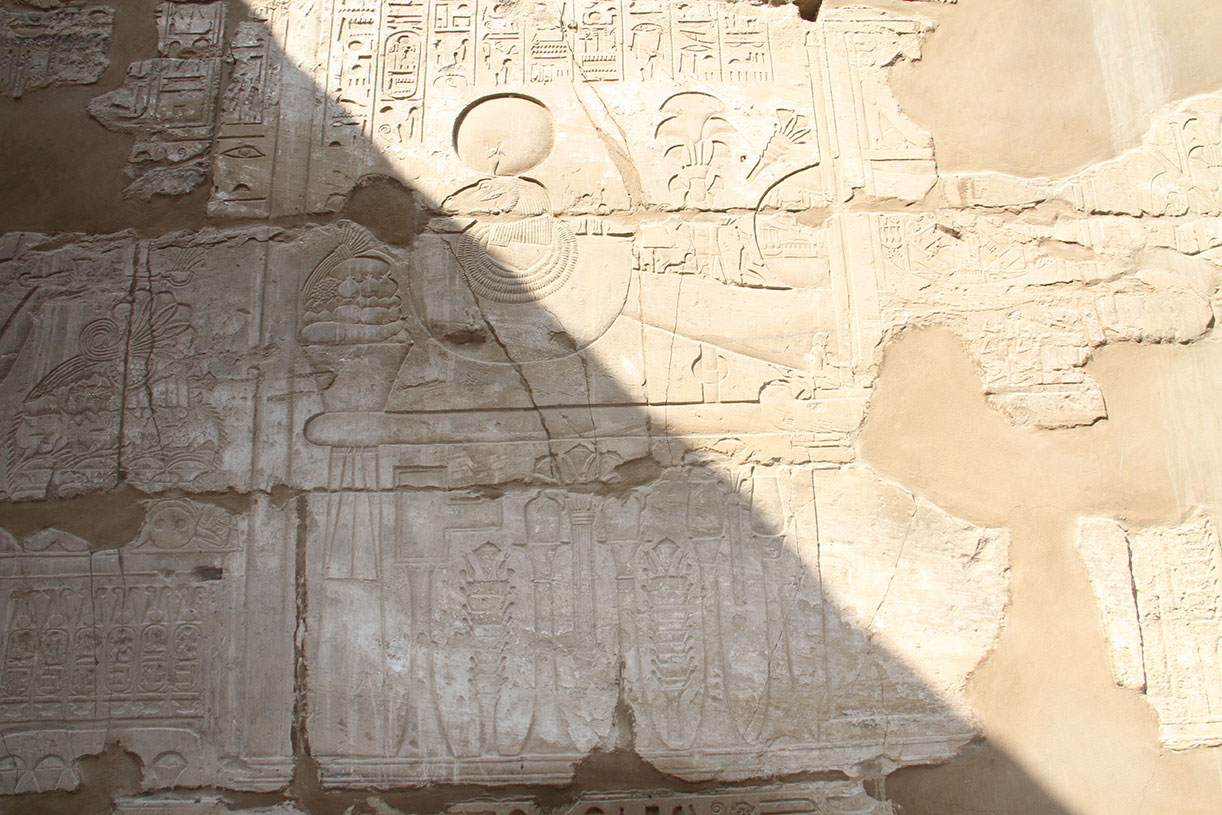
View of Ahmose-Nefertari
We find a unique view of Queen Ahmose Nefertar Wife of King Ahmose I in the presence of the god Amun and the God Taweret with the head of the serpent, then a scene of the king accepting Manaf’s magic necklace from the god Mut as in Magic in ancient Egypt.
Presentation view of the clothing boxes and the four bulls
On the western side there are scenes of the king offering sacrifices for the goddess the ancient Egyptian God Nephthys, the god Set, the god Amun-Ra ka Mut-F, God Imentet it he offers incense to the God Montu and the god Hathor, offering bread to a God Horus i swear God Isis.
View of lighting lamps
There are scenes below offering offerings to the god Amun and the god Nephthys in the form of a sphinx containing a luxurious aromatic ointment, a view of the king lighting incense and offering wine to the ancient Egyptian goddess, in addition to ruined and dilapidated scenes with a group of gods offering offerings and religious rituals of lighting lamps in front of the gods, and a view accepting the sign of life from The god Khonsu, then a view of the king worshiping the god Khonsu.
Barque Shrine of God Amun
We find the entrance to the door of the shrine of the god Mut, views from above of the emblem of Horus on the winged sun disc and around it the serpent, then the king’s titles, then a view of the king offering wine to the god Mut, and on both sides of the entrance there is a view of the king welcoming visitors wearing the red crown, then the double crown, and advising them to be pure before entering.
View of the king and Userhat of the divine boat
Scenes of the king lighting incense on the large sacred boat of the god Amun, Userhat, in addition to the ancient Egyptian gods Jesus God Ra, God Atum, God Geb, God Shu, God Tefnut, God Nut, God Set, God Osiris, God Isis, Nephthys, in addition to the goddesses Horus, Hathor, Tengit, Enet, and Sobek.
There will be an engraving on the right walls of the shrine representing the city of Thebes, “Wast,” as if it were a warrior god holding a spear.
In front of her is a chant written in hieroglyphic texts, and a scene of a king operating incense and offering wine to the sacred boat of the god Amun, in addition to repeated scenes of King Ramesses III offering offerings to a group of ancient Egyptian gods, which are present on all the walls of the temple. The crank.
Barque Shrine of God Mut:
Scenes of the king welcoming visitors and offering offerings such as wine to the god Mut and flowers to the sacred boat of the god Mut, and a scene of him receiving the sign of life “ankh” from the god Mut.
Barque Shrine of God Khonsu:
Repeated scenes of the king with the gods and religious beliefs, with the same details depicting the god Mut, with the change of the god Khonsu.
Exterior views of the temple:
There is a scene on the eastern outer walls showing King Ramesses III carrying on the royal seat. In the front are the spirits of Butu and in the back are the spirits of Nakhon, “a symbol of the ancient kings of Upper and Lower Egypt.”
Views of the decree of the year 16 of Ramesses III
Scenes of the Syrian war
The scene is located on the western outer wall, showing the king on the war chariot fighting the Syrian enemies, then scenes depicting the king chasing the Libyan.nThen a scene holding the captives.
Opet Day scenes
An inscription containing aspects of the celebration and the ancient Egyptians, starting with the musician as in Music in Ancient Egypt, the dancer, and other aspects of the holiday spread on the walls of the Karnak Temple.
Views AYd hands
It is located in the Courtyard before the Second Pylon:
Statue of King Tutankhamun
- The statue is designed in the shape of a sphinx with a marble base.
- The statue is currently in a state that requires restoration.
The Taharqa kiosk
- It consists of 10 columns of sandstone, 9 of which are now demolished, of which there is a small part and only one complete column, known as Gosq Taharqa.
- The columns were built in the era King Taharqa from Twenty-fifth Dynasty Pharaonic and more famous Kingdom of Kush kings “Black Pharaohs“.
- The column reaches 21 meters in height with capitals Papyrus.
- It was dedicated to the sacred compound resting place of the god Amun.
Statue of Ramesses II
- The statue was built in the era of King Ramesses II, King Ramses VI he wrote his name on the pedestal and rose Pinedjem I Attributing it to him and putting his name on it.
- The design of the statue is of King Ramesses II with a double crown holding the royal insignia and in front of the legs is a small statue of his daughter Anut or his wife the Queen Nefertari.
- The statue is 260 cm high and was made of pink granite.
- There is another broken statue of King Ramesses II in front of the large statue, King Ramses II has the Tomb of King Ramesses II | KV7 among the tombs of the Valley of the Kings in Luxor, the Temple of Abu Simbel in Aswan, and the Temple Ramses II in Sohag, Abydos area..
The Second Pylon
- It was built in the era King Horemheb “It has the Tomb of Horemheb | KV57 within the tombs of the Valley of the Kings, The Speos Of Horemheb in Aswan, and the Tomb of Horemheb in Saqqara.” then it was finished in an era King Ramesses I then King Ramesses II added his name to it and then developed it with many additions and developments during his reign the king Ptolemy VIII.
- The length of the second Pylon is 98 meter, the width is 30 meter, and the thickness is 14 meter.
- It was restored and the empty rooms were closed.
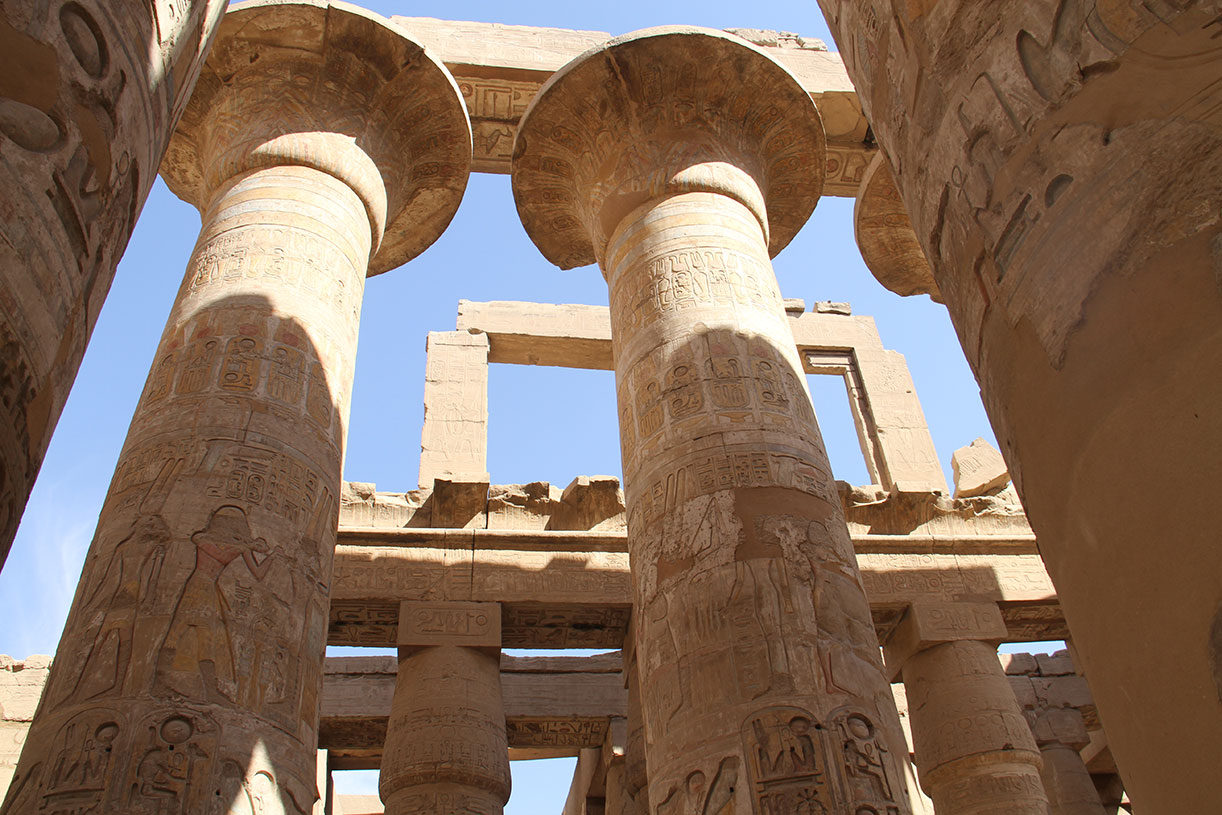
The Great Hypostyle Hall
- The columns are carved from sandstone then it was transferred to the Karnak Temple.
- The area of the Great Hypostyle Room is 5,000 square meters and contains 134 columns with capitals in the shape of Pharaonic papyrus.
- The height of the column is 20 meter and its diameter is 3 meter. The columns are distributed into 16 rows, so that each row contains 7 columns..
- He is considered King Amenophis III “Amenhotep III” the first to build 12 columns, then King Seti I “have Temple of Seti I and Tomb of King Sethi I | KV17″ built 122 columns, then King Ramesses II.
- The architectural design of the Hypostyle Hall contained a two-tiered ceiling in addition to a third ceiling in the middle of the hall “Astronomy in ancient Egypt“. The Pharaohs’ architects made windows that allowed the passage of sunlight to illuminate the entire corridor of the hall, known to the ancient Egyptians as “the procession path of the gods.”“
- King Ramses II, one of the most famous Pharaoh kings, added his royal titles to all the walls and bases of the columns, in addition to a repeated inscription on 12 columns offering offerings to the ancient Egyptian goddess.
- As a result of groundwater leaking into the entire base of the columns, about 11 columns collapsed in 1899 AD. Then the Egyptian government cooperated with foreign missions under the leadership of archaeologist Georges Albert Legrain to restore the columns until they were completed in 1902 AD..
Who built the Hypostyle Hall in Karnak Temple?
- King Amenhotep III “It has the Temple of Amenhotep III in El Kab, Mortuary Temple of Amenhotep III, The Tomb of Amenhotep III | KV22 / WV22 in Deir el-Bahri, and Palace of Malkata” is considered the first king to build 12 columns with Pharaonic papyrus capitals dating back to 1390-1352 BC from the 18th Dynasty..
- King Seti I, who built 122 columns, but the length of the column = 15 meter, in addition to its current decorations, dated 1294-1279 BC..
- King Ramesses II added his name in royal Egyptian Cartouche to all columns dated 1279-1213 BC. Nineteenth Dynasty Pharaonic.
Hypostyle Hall Inscription:
The Hypostyle Hall contains an inscription of King Ramesses II with the triad gods of the city of Thebes as in Egyptian Mythology, inscriptions of the victories of King Seti I and King Ramesses II, and drawings of royal funeral processions in the Pharaonic civilization.
North Wall Inscription:
The colonnaded walls of the northern wall contain scenes of King Seti I kneeling under the sacred tree in front ofAncient Egyptian goddessThen an inscription of the king during his moment of victory over Egypt’s Asian enemiesIt is spread on all the walls of Karnak Temple.
King Seti I used to use the northern wall area as a temple to perform religious rituals, as was the ancient belief of the Pharaohs.
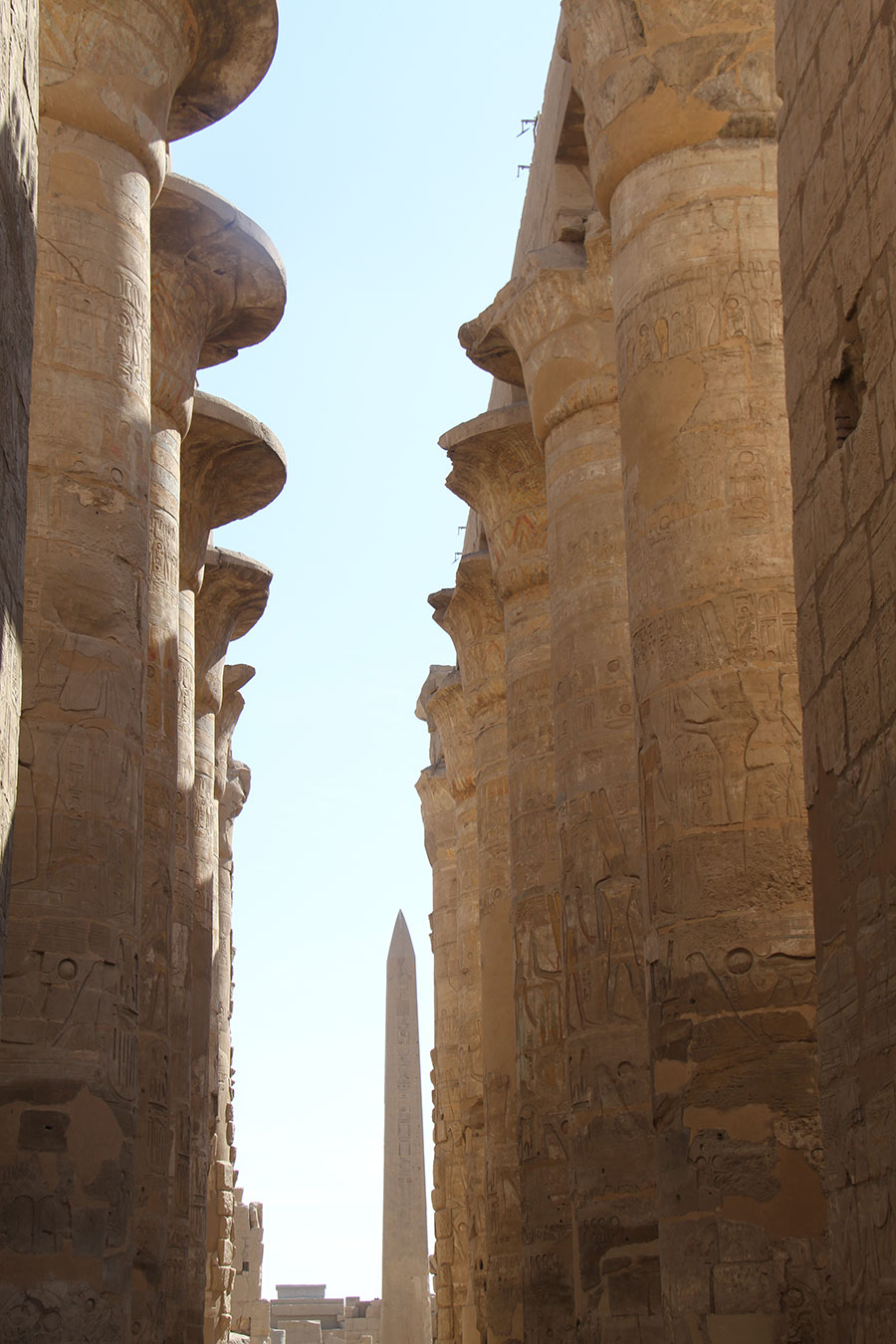
Inscription on the South Wall:
You will see an inscription of King Ramesses II carrying incense in front of the boat of the god Amun, a group of priests wearing the mask of a falcon, another group with the heads of the sons of Ui, then the boat of the god Khonsu and the god Mut..
You will see an inscription of King Ramesses II at the moment of his victory over the Syrians, in addition to an inscription containing texts in the ancient Egyptian language that tells the details Battle of Kadesh Historically, the ancient Egyptian writer and poet Pentaor wrote these poems and engraved them on the walls of the columns.
You will see royal inscriptions with the names of kings on the walls, such as the cartouches of King Ramesses III and King Ramesses IV of the Twentieth Pharaonic Egyptian Dynasty. He has the Tomb of King Ramesses IV | KV2 in the Valley of the Kings and King Ramesses VI has a royal tomb with his brother King Ramses V in the Tomb of King Ramses V + King Ramesses VI | KV9 and King Herihor of the Twenty-first Egyptian Dynasty.
The Obelisk of Thutmose I
5 meters long.
It was built in the era of King Thutmose I and has the Tomb of King Thutmose I + Queen Hatshepsut | KV20 in the Valley of the Kings in Luxor
Third Pylon
It was built during the era of King Amenhotep III.
The following was discovered inside it:
- Granite stone base Pink Engraved with name King Amenemhat III and King Amenemhat IV.
- Limestones containing an inscription indicating a period of rule King Ahmose I, Queen Ahmose-Nefertari, King Amenhotep I and King Thutmose II.
- A private resting cabin for the sacred boat for king Amenhotep I “Tomb of Amenhotep I | KV39″ made of alabaster stone.
- Lintel made of stone Sandy Refers to a period of rule King Thutmose II.
- A group of huge stone blocks made of limestone for the entrance to the temple of King Amenhotep III.
- Remains of a resting cabin for the sacred boat made of red quartz stone especially for Queen Hatshepsut.
- Remains of a resting cabin for the sacred boat made of alabaster belonging to King Tuthmosis III.
- The complete stones of the shrine of King Senusret I, “have the Obelisk of Senusret I in Fayoum and the Pyramid of Senusret I in Giza, were restored to a small shrine in the north of the courtyard of the Karnak temple complex.
- Remains of an alabaster ceiling and a stone plaque made of red granite with a scene engraved on it King Amenhotep II “Tomb of King Amenhotep II | KV35″ he practices archery.
- Remains of a column and a boat base made of sandstone dating back to the Hakam period King Thutmose IV “have Tomb of Thutmose IV + Prince Amenemhat son of Thutmose III, and Princess”.
- A dilapidated stone plaque from the era of King Ahmose.
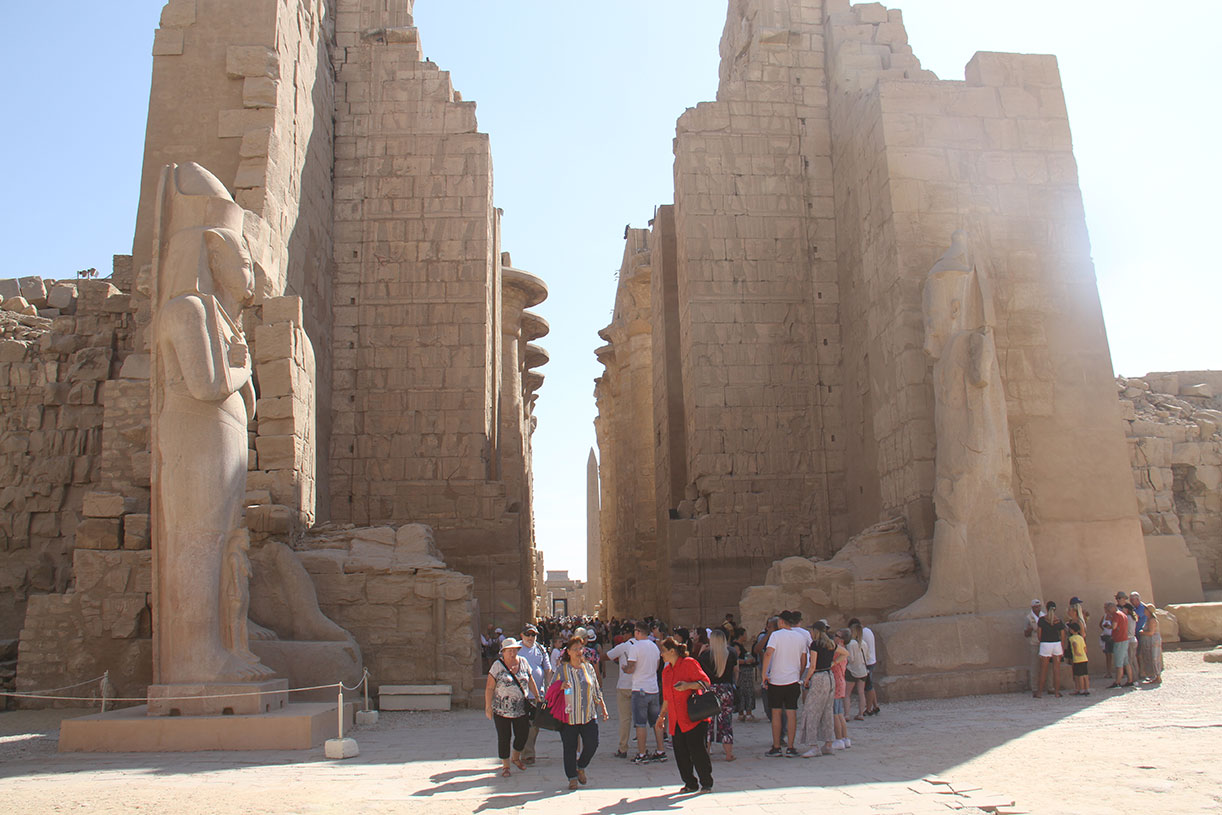
Fourth Pylon
Hall of Legends
- Also calledKing’s gallery King Thutmose I the hall was built during the era of King Tuthmosis I.
- The ceiling of the hall was made of cedar wood, and the columns contained empty spaces in which small statues of King Thutmose I were placed.
- waiting roomThe king’s own Thutmose III is between the fifth and sixth towers.
Hatshepsut Obelisk
- The Obelisk of Queen Hatshepsut is considered one of the largest obelisks in the Karnak Temple Complex.
- It is made of red granite stone.
- The obelisk is 40 meters long and rests on a base with a side 65 meters long.
Fifth Pylon
- It is currently considered dilapidated and dilapidated.
- The fifth Pylon was built during the era of King Thutmose I.
Sixth Pylon
- It was built in the era of King Tuthmosis III.
- The Pylon was built of sandstone with a granite entrance.
Tutankhamun Hall
- It contains two columns of pink granite stone with papyrus flower capitals and the other The Pharaonic Lotus Flower.
- In front of the hall there is a statue of the god Mut and a statue of the god Moon. They were carved and added in front of the hall during the era of King Tutankhamun. After his death, King Horemheb attributed the two statues to him.
Holy of the Holies of Philip Arrhidaeus:
- It was built during the reign of King Philip III Arrhidaeus in the Greek-Roman era, known as the arrival of Alexander the Great to Egypt and the beginning of the rule of the Greek-Macedonian dynasty.
- It contains ceiling scenes of religious rituals.
Festival Hall of Tuthmosis III
- The columns retain very beautiful decorations and colors that are more than 3400 years old BC.
- The hall was used for celebrations and ceremonies of the God Opet Festival, which is held every year.
- King Thutmose III of the 18th Pharaonic Dynasty built the hall in the middle of the Karnak Temple.
- The entrance to the hall contained two statues of King Tuthmosis III in official royal ceremonial attire.
- The Tuthmosis III Festival Hall contains 32 columns in a square shape with a roof at the top to allow sunlight to enter. Then the inner part contains a group of columns in the form of a tent column that was used by King Thutmose III during his military wars..
- In the northeastern direction, you will find a staircase that reaches a room containing antique water clocks made of stone in the shape of a bowl containing a small opening for water to flow at a constant rate. It is called the “Clepsydra Room.”“.
- Water clocks were used in the hall to set times Priests Karnak Temple and the god Amun Ra to carry out daily religious rites and rituals for them.
- King Thutmose III built a royal court for King Thutmose I in 1493 – 1482 BC.
- The hall was built in the 23rd year of the reign of King Tuthmosis III.
- The building period of the hall took 7 years.
- The Tuthmosis III Festival Hall is located in the middle of the area of the god Amun-Ra in the Karnak Temple in Luxor, Egypt.
- The Thutmose III Festival Hall was built for the official Dam Day celebrations for the Pharaonic Dynasty 18 during the reign of King Thutmose III..
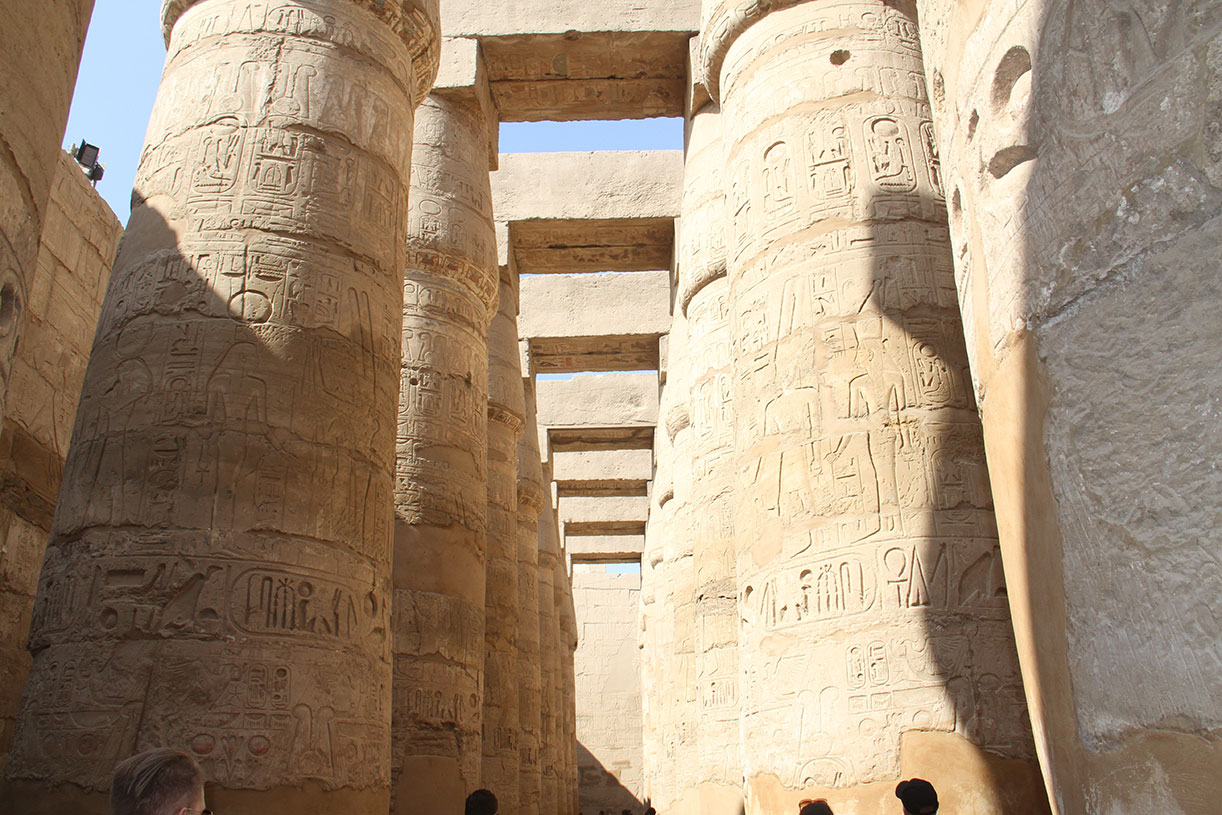
Map and design of the Tuthmosis III Festival Hall:
- The hall was built in the eastern direction of the Karnak Temple and is surrounded by stone walls.
- The hall consists of three parts: the southeast area, the northeast area, and the festival hall.
- You will see an inscription on the walls of the hall of the botanical garden of King Tuthmosis III.
- In the main room, known as the Ancestral Room, you will see an inscription of all the Pharaoh kings who contributed to the construction of the Karnak Temple from Pharaonic Cartridges for the names of the kings of the Pharaohs across History of the Pharaonic civilization.
- The original copy has been deleted and removed from the list of kings of Karnak Temple as Abydos King List, and King Tuthmosis III offers sacrifices to more than 61 Pharaonic kings. The original copy is displayed in Louvre Museum in Paris, France.
- In ancient times, the hall contained a door as the main entrance to the hall surrounded by two columns and two Osirian statues.
- You will see a long corridor whose side walls contain scenes of the ancient Egyptian celebrations of the royal jubilee, in addition to the corridor being connected to 9 small rooms that were used to store food and offerings, in addition to special rooms for priests and religious rituals..
- You will see Pharaonic inscriptions on the walls of the rooms depicting scenes of pots and pans and some religious rituals that were performed by the priests in the ancient Egyptian civilization..
- In the northern direction, you will see a vestibule and a small room that we talked about previously, known as the ancestral chapel, which contains a list of 61 Pharaonic kings before King Tuthmosis III.
- After completing the ancestral prayer room, we find a large hall with a width of 44 meters * 16 meters, known as the Hiret Ibb Hall. The hall contains 32 columns and 10 columns in two rows..
- Moving a little forward, we find 3 chapels containing an inscription of offering sacrifices to the ancient Egyptian goddess, funeral processions, and devotional rituals of King Tuthmosis III offering sacrifices to the ancient Egyptian goddess..
- Then we find a room containing 8 columns that was dedicated to worshiping the god of the underworld, as was believed by the ancient Egyptians..
- In the northeastern direction, we find a room containing 4 columns in the shape of papyrus, and the walls contain views of the Syrian Garden for a group of plants and animals. The room is called “The Botanical Garden of Tuthmosis III.”“.
- After that, we find a room containing 8 ancient niches, where each warrior contains a statue.
Temple of Ptah In Karnak Temple
- King Tuthmosis III of the 18th Dynasty built a special temple to the god Ptah on the ruins of a small temple from the Middle Kingdom in the eighteenth century BC..
- The Pharaohs kings of the era were interested The Ptolemaic Pharaonic example Emperor Tiberius Caesar Expanding the temple and building some buildings in it in the first century AD.
- The primary goal is the worship of the god Ptah, his wife Sekhmet, “the god of war,” and their son God Nefertem one of the most important gods and religious beliefs of the ancient Egyptians.
- A group of statues of ancient Egyptian gods such as Osiris and Mut were discoveredI swear God Bastet.
- A stone plaque bearing the name of the god Ptah was discovered.
- The oldest part of the Temple of Ptah consists of a cell structure built in the era of King Tuthmosis III.
- The temple contains a room dedicated to the worship of the god Amun Ra.
- From the main hall you can access a special room for worshiping the god Hathor and the other for the god Ptah.
- The temple’s decorations were completely completed during the reign of King Thutmose III, such as the decorations of the walls and the portico, while the courtyard and the northern part were decorated by King Horemheb & Ptolemy IV.
- The Ptolemy III Euergetes to IV built many buildings in the outer courtyard of the temple.
Temple of Ptah Map & from the inside:
- The architectural design of the temple was based on building 6 gates close to each other. The first and second gates were built in the Ptolemaic era, while the third gate contains two columns interconnected with the fourth gate..
- The fifth gate reaches a portico containing 4 columns, while the sixth gate passes through a group of towers
- Then we find the statue of the god Ptah.
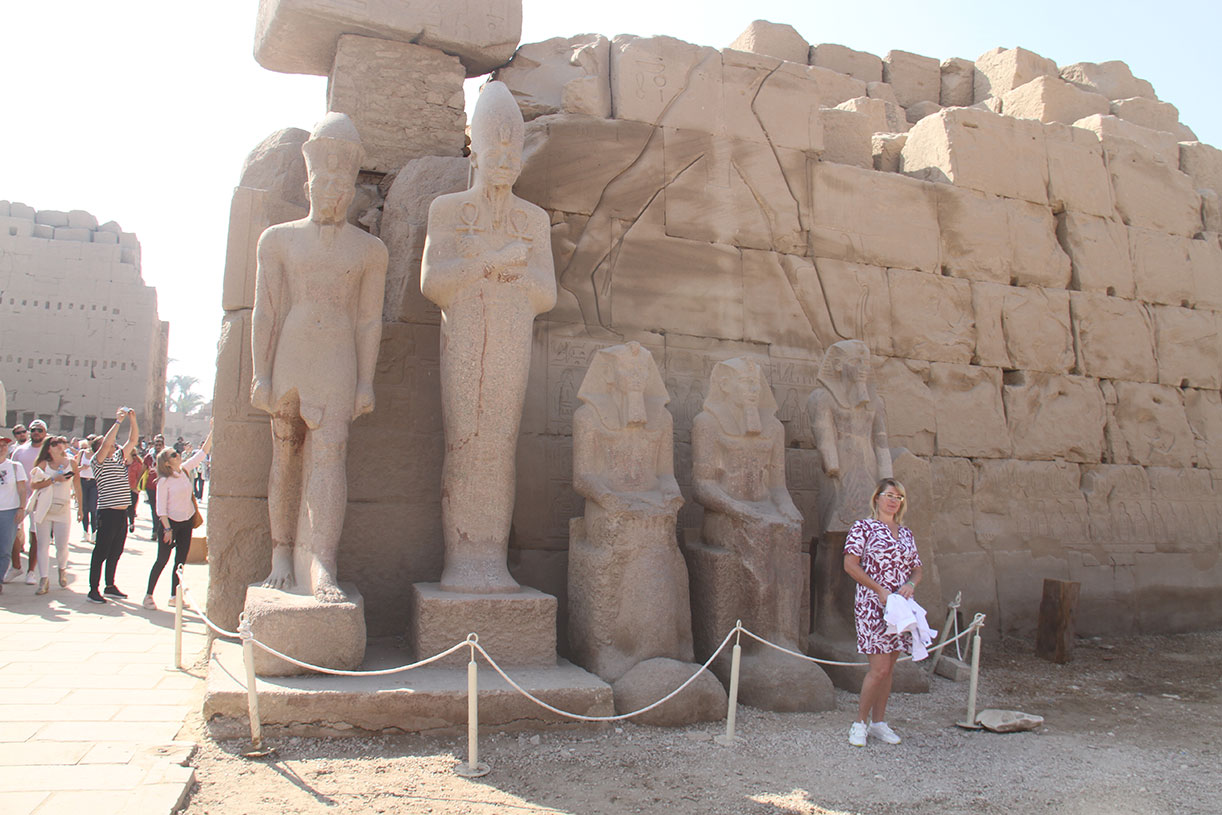
Temple of Ptah Inscriptions on the walls:
- On the walls of the first gate you will see cartouches for the King Ptolemy VI then there are corridors whose walls contain scenes of the king Ptolemy XI and the King Ptolemy XIII then an inscription of the god Nefertum carrying the sacred Pharaonic lotus flower.
- Gate No. 2, 3, and 4 contain the cartouches of King Ptolemy XIII, and Gate No. 5 contains royal cartouches of King Tuthmosis III and King Ptolemy III..
- You will see a distinctive engraving of King Tuthmosis III wearing the white crown of Egypt and the other side wearing the red crown at the sixth gate.
- There are distinctive inscriptions inside the sacred room at the end of the corridor, which contains scenes of the scepter of the god Amun Ra, in addition to Pharaonic inscriptions on the walls..
- You will see a statue of the god Ptah and another statue of the god Sekhmet in the sacred room inside the temple.
Who is the symbol Ptah?
- He is one of the most important gods and religious beliefs of the ancient Egyptian Pharaohs, as he was part of the triad of the city of Memphis..
- He was considered the symbol and god of architects in ancient Egyptian religion.
- The god Ptah is the husband of Sekhmet and his son is the god Nefertum.
- The ancient Egyptians believed thatHAl-Hakim’s father Imhotep.
Temple of Osiris – Osiris Shrine
Sacred Lake
- The water level in the lake has not yet dried up or changed after more than 3,000 years.
- The engineering miracle of the lake’s design is considered one of the secrets of life in the Pharaonic civilization and the most important Pharaonic shrines and monuments. In Karnak Temple the water level of the sacred lake since more than 3000 years BC and up to the present time has not dried up or there has been an increase or decrease in the level even at the time of the flood of the Nile River.
- The lake was surrounded by a large wall, but it is currently dilapidated as a result of erosion and climate conditions.
- You will see a gauge of the Nile River water located on the southern and northern sides of the lake to know the dates of the Nile River flood each year..
- You will also see stairs and ladders to go down to the lake, with a small boat in it for picnicking.
- The lake was supplied with two entrances from the eastern and western sides to prevent excess water flow.
- The lake is extended by the waters of the Nile River through a small canal.
- The lake is 80 meters long and 40 meters wide.
- The ancient Egyptians used to let ducks and birds swim in the lake to obtain blessings, and then they slaughtered them to serve them at the king’s banquets and the royal palace..
- In the past, the lake was surrounded by small houses for priests and cages for keeping birds.
- The lake was built during the era of King Thutmose III in 1473 – 1458 BC.
- The lake was used to purify and wash the priests of the Temple of Amun Ra and the Pharaoh kings as one of the religious rituals to worship the ancient Egyptian gods before performing religious celebrations and ceremonies..
- It was home to the sacred geese of Amun, where the shape of the goose birds was a symbol of the god Amun Ra among the ancient Egyptians..
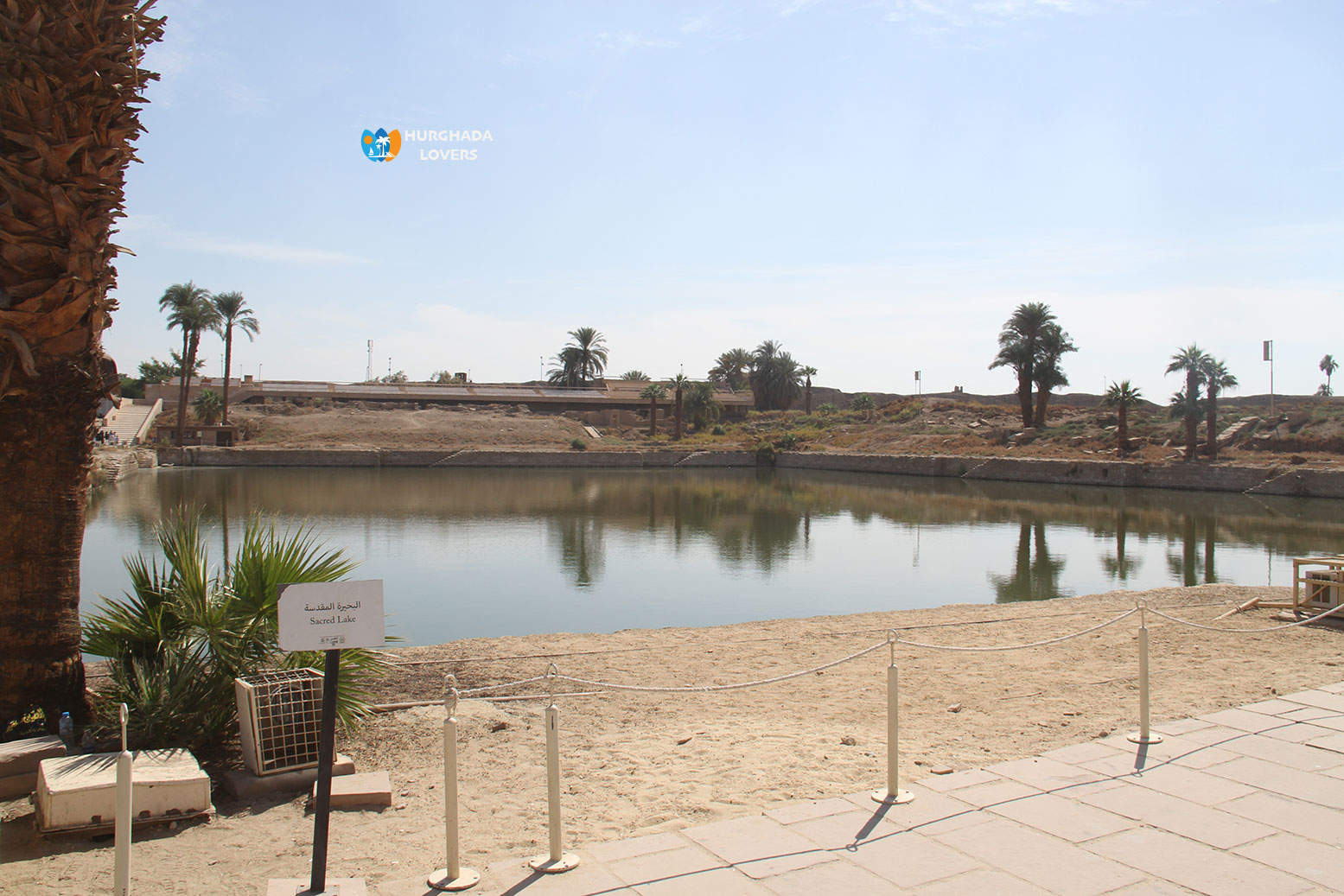
What are the legends associated with the Holy Lake?
- It is a myth that the destruction of humans from the face of the earth begins with the decline in the lake’s water level.
- The second myth is that women who face the problem of infertility and lack of children come to the lake in order to conceive a child and give birth quickly.
- The lake’s water treats many diseases that medicine has not yet treated.
- Many people in Luxor believe that whoever comes to the lake and tells it his dreams will come true.
Scarab of King Amenhotep III in Karnak Temple – The kheper Monumental Scarab:
- The scarab was built and carved from granite during the era of King Amenhotep III for his wife, Queen Tiye, as a gift to her and to express his love to her.
- The scarab represents the God Khepri and rests on a base with engravings of King Amenhotep III in a kneeling position offering wine to the God Aton to grant him immortality.
- Tourists circle around it 7 times, “an ancient Egyptian custom as a pilgrimage ritual,” to bring luck, happiness, and fulfillment of wishes.
Myths for those who circle the sacred scarab 7 times:
- Pregnant women give birth easily and quickly.
- An unmarried young man or woman who dreams of marriage gets married quickly.
- Fulfilling your wishes and dreams.
The Courtyard of the Cachette
Seventh Pylon
- Almost demolished.
- It was built in the era of King Tuthmosis III.
- The walls of the Pylon contain scenes of the king fighting Nubian Southern Egypt and East Asian and he conquers them.
The courtyard between the seventh and eighth towers
White limestone statue before the eighth pylon.
Eighth Pylon
- It was built in the era of Queen Hatshepsut and completed by King Thutmose III. After it was destroyed, it was restored in the era of King Seti I.
- In front of the eighth pylon are 4 huge statues of King Thutmose III, King Amenhotep I, and 2 statues of King Thutmose III.
Ninth Pylon
- It was built by King Horemheb.
- The Pylon is currently dilapidated and dilapidated.
- A group of huge stones “talatalat” was used to build it from the temple of King Akhenaton. He carried out a religious revolution with his wife, Queen Nefertiti, and Queen Kiya. He has the Royal Tomb of Akhenaten “Amenhotep Iv” among the Tombs of the Nobles Amarna at Tell el-Amarna in Tell el-Amarna in Minya, which is located east of the Temple of Karnak.
Tenth Pylon
- It was built in the eraKing Horemheb.
- The Pylon is currently demolished.
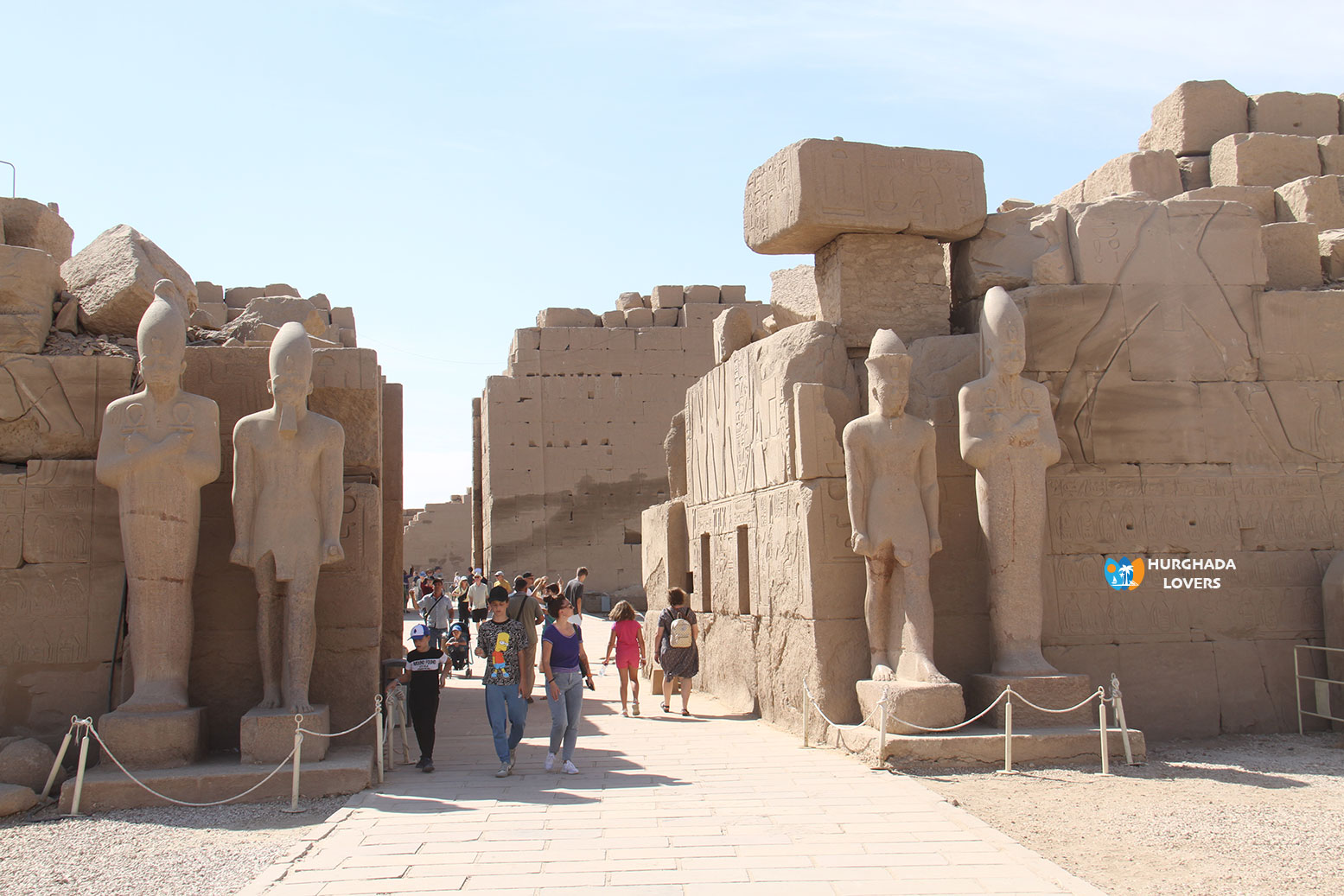
Mut Temple in Karnak Temple
- The temple was built to worship the goddess Mut, as there is an inscription on the facade of the temple entitled “The Temple of the Great God Mut, Raya Ishru.”“.
- The beginning was in 1801 AD, with a description of Egypt’s historical landmarks through the French expedition report Led by military leader Napoleon Bonaparte..
- In 1845 AD, English archaeologist and Egyptologist John Gardner Wilkinson and German archaeologist Dr. Karl Richard Lepsius made a simple architectural study of the temple..
- Archaeologist Margaret Benson and archaeologist Janet Gourlay conducted a major academic study of the temple..
- In 1991 AD, a mission from the Brooklyn Museum in “New York City, USA”.
- In 2001, archaeological researcher Dr. Betsy M. Bryan, in cooperation with Johns Hopkins University until 2004, excavated the area..
- In the year 2015 AD, a mission was conducted by Dr. Brian prospecting in the area.
- King Amenemhat I is considered the first to build the foundations of the temple of the god Mut in the era of the Middle Kingdom of the Pharaohs, and then King Amenhotep III completely built the rest of the temple parts..
- Royal cartridges dating back to the era of King Thutmose II and King Thutmose III of the 18th Dynasty were discovered.
- King Ramesses II carved two statues and paintings from marble in the temple
- King Ramesses III built the temple for himself, but it was used Until the kings of the Twenty-fifth Dynasty of Egypt, the period of the rule of king Piye, then it became a quarry for renovating and restoring the temples in Karnak.
- King Taharqa of the Twenty-fifth Dynasty built a gate and built a colonnade facing south, in addition to some buildingsAnd restorationsIn the temple of Mut itself.
- During the Ptolemaic era, King Ptolemy VI built a church within the temple complex at Karnak “One of the most famous Coptic Egyptian Antiquities of the Coptic period“.
- A foot-long statue of King Amenemhat I was discovered inscribed with texts Dedicate itIn ancient Egyptian language, it turns out that the temple was built during the era of the Pharaonic king.
- A piece of stone was discovered at the base of the statue of the priest Amenemhatankh. He was one of the priests in the temples of King Amenemhat III. Famous Pharaohs kings throughout history.
- A statue of King Amenhotep I was discovered, with the goddess Mut sitting on his knee.
- Small statues of priest Habu-Senepe and priest Wasan-en-Mut were found from the era of Queen Hatshepsut.
- Stone panels containing archaeological inscriptions from the era of King Tuthmosis III were found.
- A statue of the young Pharaoh King Tutankhamun was found during excavations in the courtyardthe second.
- A life-sized statue of Queen Tiye, wife of King Amenhotep III of the 21st Pharaonic Dynasty, made of granite, was discovered..
- Temple area = 5000 square meter.
- The area of the Mut Temple complex with the outer wall = 90,000 square meters.
- The complex contains 6 temples.
- The temple was built of sandstone.
Mut Temple Map & Interior Design:
The temple is surrounded by a large wall that was built in the 30th Dynasty of Pharaohs by King Nectanebo II. You can reach the gate of the temple wall through the path of rams at the tenth pylon in Karnak, which contains 130 ram-headed statues.Abu Al-HutoA symbol of the god Amun.
Inside the wall you will see 6 Pharaonic temples, which are the main Temple of Mut, the Temple of King Ramesses II, the Temple of King Ramesses III, and two other temples..
In the northern direction you will find a large Pylon, built in the king’s era Ptolemy II.
You will see another Pylon that was built during the era of King Amenhotep III. It was discovered that King Seti II and King Ramesses III restored the Pylon and engraved the royal name on the Pylon, in addition to a royal cartouche in the name of King Ptolemy VI..
After completing the first Pylon, you will see an open courtyard that contained 10 columns with papyrus flower capitals in two rows, but the columns were demolished and only a few of them remain now..
Next to the courtyard is the second Pylon, but it is demolished, but the western tower was restored by the Brooklyn Museum mission in Germany. It is made of mud brick, 3 meters high. A special cartouche was discovered.BKing Nectanebo I.
After the second pylon, there is another open courtyard, but it is currently demolished. It contained 4 square columns with Hathorian capitals in two rows. Statues were discovered.King Sheshenq IKing Tutankhamun and a cartouche of King Ramesses II inside the courtyard.
After the second courtyard, we find the Hypostyle Hall, but it is currently demolished. It used to contain 8 columns in two rows.
At the end of the Temple of Mut, we find rooms that were designated for storing offerings and the Holy Mass Room that connects you to the Holy Lake. A group of sandstone statues of baboons were discovered on the western side of the temple..
You will see an inscription and scenes on the first pylon of the God Bes one of the most important religious beliefs of the ancient Egyptians.
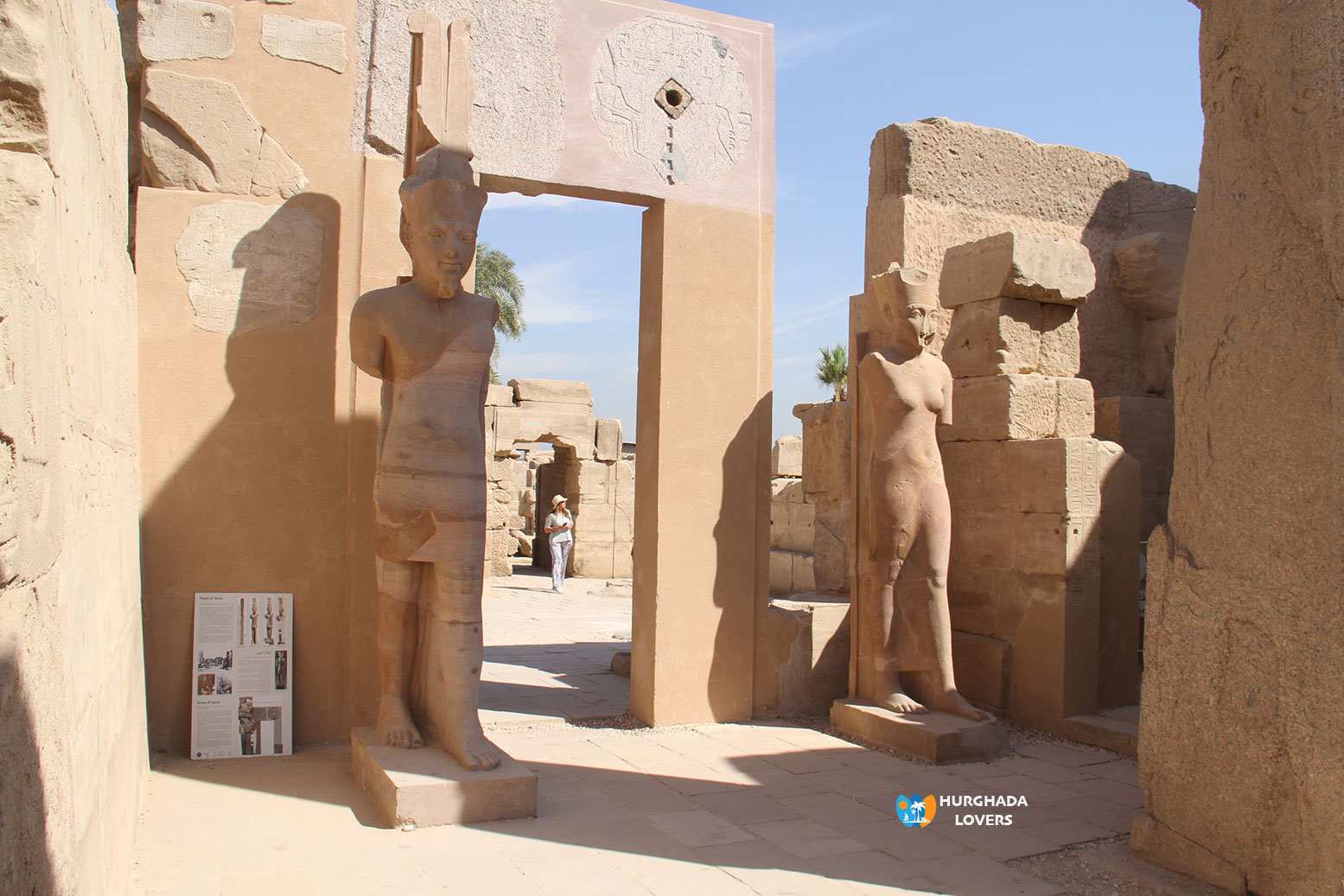
Who is God Mut?
- The god Mut is one of the most important religious beliefs among the ancient Egyptians, as she is the wife of the god Amun Ra and was called the mother god and the lady of the sky, as one of the sky gods of the Pharaohs..
- The god Mut was symbolized by an eagle, a lioness, and the crown of Oros.
- Mut is considered part of the triad of the city of Thebes, along with the god Amun Ra and the god Khonsu.
- The goddess Mut was the guide to the god Khonsu, the moon god of the ancient Egyptians.
Khonsu Temple in the Karnak Temple
- The Temple of Khonsu was built in the era of King Ramesses III.
- King Ptolemy III built the door and the outer walls of the temple.
- He roseKing Nectanebo I Building the Hypostyle Hall at the entrance.
- King Seti I built baboon statues inside the temple.
- The god Khonsu is one of the gods and religious beliefs in the ancient Egyptian civilization, and he symbolized the moon.
- It was built during the era of King Ramesses III, one of the famous Pharaoh kings throughout history, from the 20th Dynasty to the eras of the New Pharaonic Kingdom of Egypt..
- It was built on the ruins of an ancient, dilapidated temple during the era of King Ramesses III.
- The priest Herihor, who became a Pharaoh and took over the rule of ancient Egypt in 1085 BC and in Panjem, was interested in introducing Pharaonic decorations and inscriptions on the walls of the front courtyard of the temple and completing a group of buildings and structures in the temple..
- In the era of King Ptolemy III, the outer gate and the outer temple wall were built.
- King Nectanebo I built the colonnade inside the temple and the large hypostyle hall.
- A group of statues of baboons was built during the reign of King Seti I.
- The temple contains statues of the god Khonsu, known to the ancient Egyptians as the moon god in the form of a monkey.
- The temple contains decorations and inscriptions on the walls and columns of the halls of King Ramesses IV and a group of people.
- You will see an inscription on the walls of the columns of King Herihor offering sacrifices to the god Khonsu and a group of ancient Egyptian gods and beliefs..
Khonsu Temple Map:
You can reach the temple through a stone road starting from the Temple of Amun Ra in Karnak.
The temple’s layout begins with a terraced courtyard surrounded by 28 columns, then a hall of columns, then an integrated structure in the style Baroque A pillared hall, rooms for worship, and a staircase that reaches the roof of the temple.
The layout of the temple’s facade, south-north to southwest, is different from the rest of the temples in Luxor.
You will first see a corridor containing statues in the form of rams on both sides, then a large Pylon 32 meters long, 18 meters high and 9 meters wide, then the facade of the temple, then a group of rooms, then a large open courtyard containing 20 columns that was built for the feast of King Herihor.
The temple contains a rectangular room containing 8 columns distributed in 4 rows. It also contains 3 rooms for worshiping the Trinity of the city of Thebes and rooms for storing offerings and worship..
The temple was built to worship the ancient Egyptian moon god, one of the most important ancient religious beliefs, known as the god Khonsu.
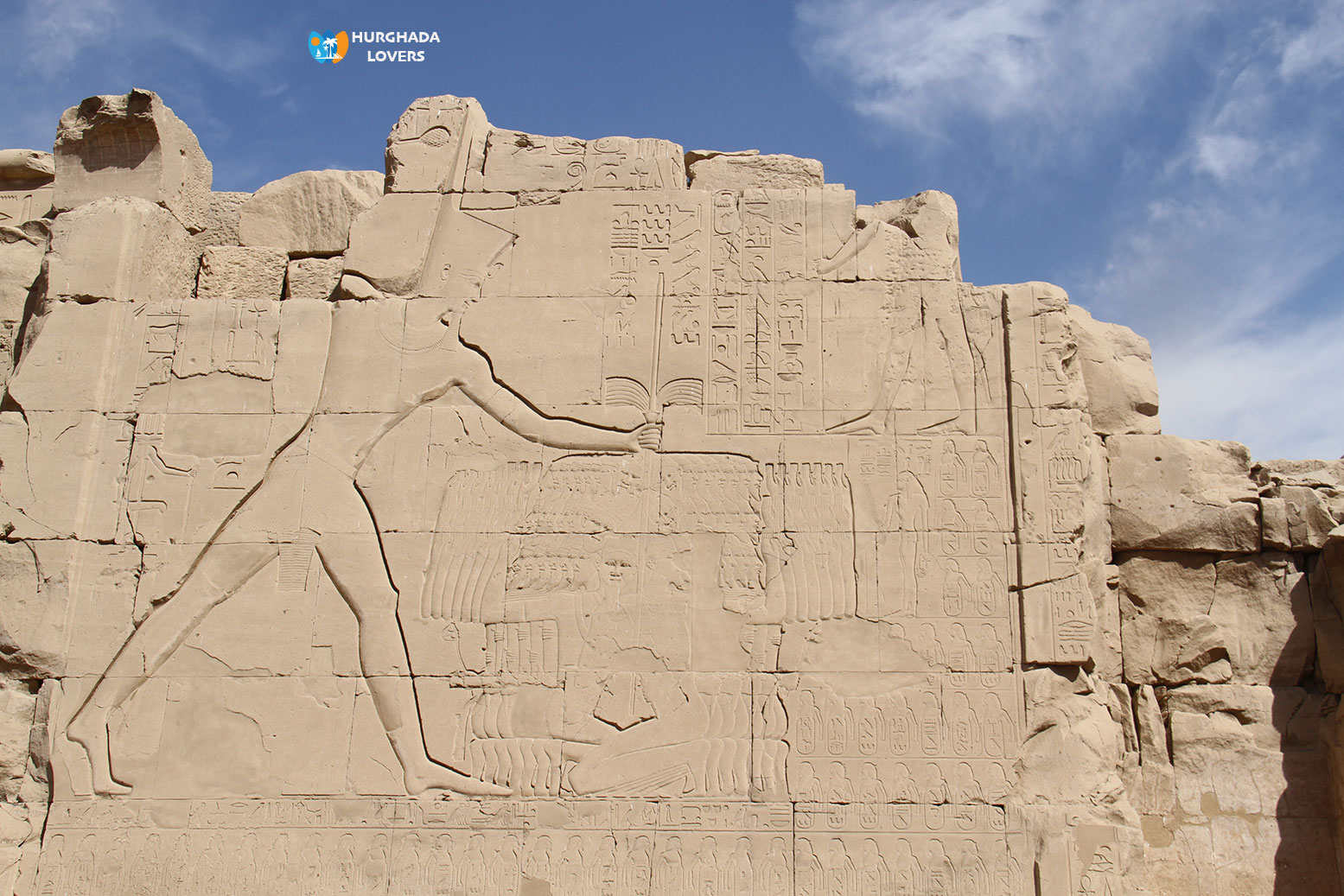
Who is the god Khonsu?
- He is the moon god of the ancient Egyptian Pharaohs and the son of the goddesses Amun and Mut.
- Special feasts for the god Khonsu were held annually, such as the beginning of the new year. Here there were special rituals for this celebration. The Egyptians placed the statue of the god Khonsu on a boat and it was transported from the Karnak Temple.To a templeLuxor with statues of the gods Amun and Mut.
- You will see a special engraving of the god Khonsu in the form of a nomad with a falcon’s head, surmounted by a moon disk and a lock of hair, in addition to the shape of a baboon..
- The ancient Egyptians believed that it fights and expels evil spirits.
Gateway of Ptolemy III Euergetes
Temple of Amenhotep IV in Karnak Temple
- The temple was built in the era of King Akhenaton of the 18th Dynasty, especially in the first four years of the Meccan rule period before the revolution “Revolutions in Ancient Egypt” to unify religions and build a city Tell el-Amarna.
- The temple is located outside the area of Amun Ra, towards the east, in the Karnak Temple, Luxor, Egypt.
- It was discovered that the temple was originally a religious Pylon for King Amenhotep III and was used as a memorial in the Karnak Temple. Then, King Akhenaten used the structures of the Pylon and built his own temple..
- The temple was without a roof and was directly exposed to the sun’s rays.
- The temple contained statues made of red granite and sandstone of King Akhenaten.
- Parts of the temple walls, known as the Tiny List, have been collected and are now displayed in the Luxor Museum “Museums in Luxor“, where you will find inscriptions and scenes of the celebration of Sid’s Day, which King Akhenaten and King Amenhotep III were interested in Sed festival, in addition to drawings of residential life, administration, and ownership in the civilization of ancient Egypt..
- The temple was destroyed after the death of King Akhenaten and the temple layout disappeared until now.
- More than 25 artifacts from the statues of King Akhenaten were discovered after extensive excavations by American Egyptologist and archaeologist Dr. Henry George Fisher in 1925 AD..
- A huge statue of the Pharaonic king, 13 meters long, and another statue approximately 9 meters long. The external sculpture of the statue showed the king with a large stomach, large facial features, and a small arm, while the other statue was without genital organs and naked..
- 25 stone bases were discovered that were intended for statues of King Amenhotep IV.
- A stone block was discovered inscribed with King Akhenaten raising his right arm and wearing the blue crown of ancient Egypt. On the left is an engraving of the god Aten with the head of a falcon. It is currently on display in Berlin Museum In Germany.
Wall:
- Blocks made of sandstone decorated with Pharaonic administrative and royal life were discovered and were located in the ninth pylon of the Karnak Temple in Luxor during the temple reconstruction work..
- 40,000 pieces were found and completely reassembled and are currently displayed in many museums around the world and on a wall in the Luxor Museum..
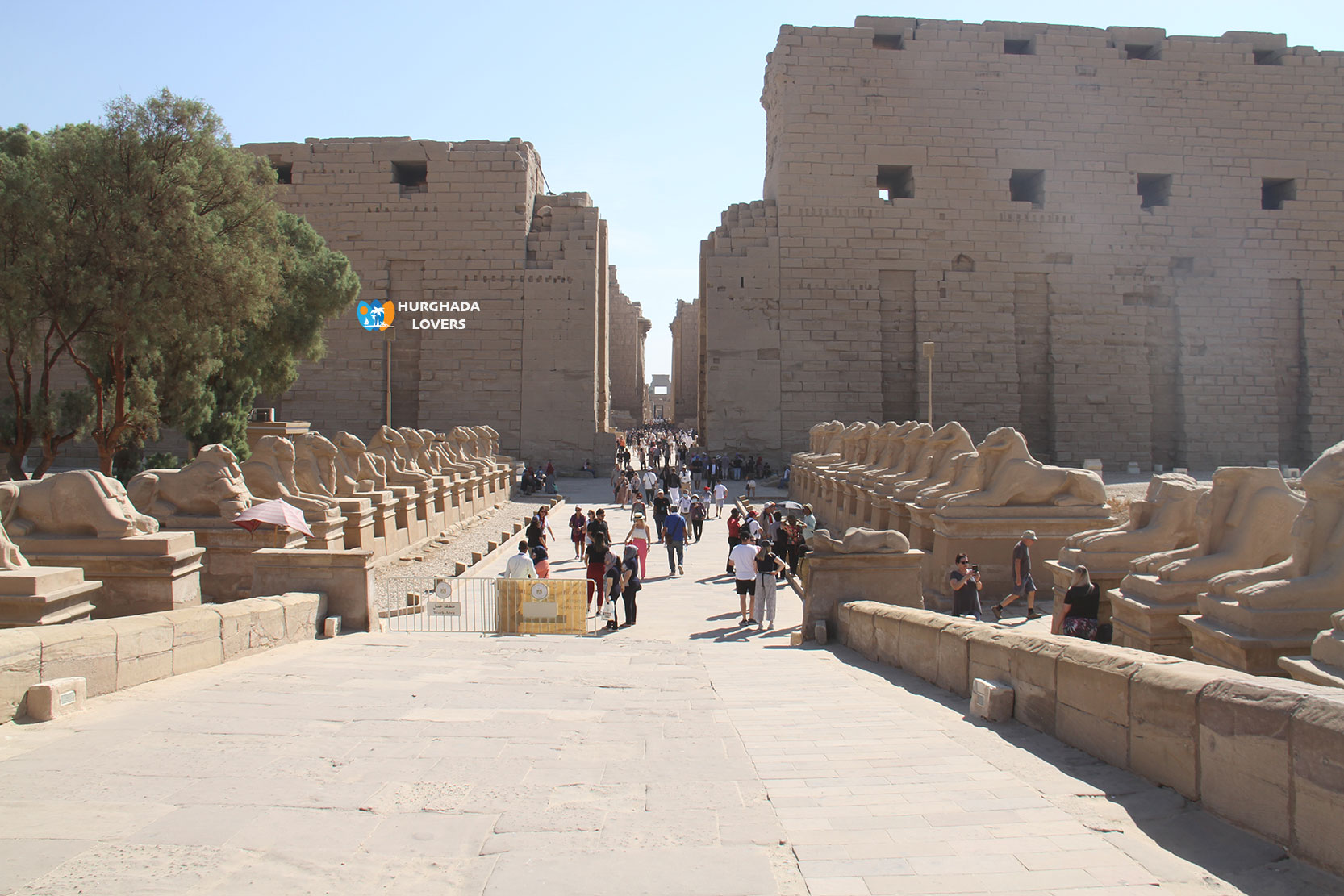
God Montu Temple:
- It’s called Monthu Temple or Montgo.
- It was built to worship the God Montu, “the symbol of war among the Pharaohs.”
- The temple is located northeast of the Karnak temple complex.
- It was built in the era of King Senusret III and includes the Pyramid of Senusret III in Saqqara, among the AbuSir Pyramids.
Temple of the goddess Epet – God Taweret:
- The temple was built to worship the God Taweret.
- It was built in the era of King Ptolemy VIII.
The White Chapel Temple in Karnak Temple
- King Senusret I built the Jubilee Temple in 1971 – 1926 BC during the Middle Kingdom era of ancient Egypt..
- King Amenhotep III completely demolished the structure during his reign in 1390 – 1352 BC.
- The temple’s stones were used to build the third pylon in the courtyard of the Amun-Re area in Karnak.
- The structure was built of limestone.
- The height of the column in the structure is 2.6 metres, the width is 0.6 metres, and the depth is 0.6 metres.
- Platform height is 1.2 metresAnd takeA square shape measuring 6.8 meters by 6.5 metres.
- After the third Pylon at Karnak was exposed to a major earthquake in 1924 AD, it was discovered that the stone blocks of the white structure had collapsed. A decision was taken by the Egyptian government at that time to completely reassemble and restore the structure and dismantle the dilapidated third Pylon..
- King Senusret I built the temple to celebrate the annual Sid’s Day, which is the most important official holiday and festival in ancient Egypt’s civilization.
- The structure was used as a sacred shrine by Pharaonic kings such as King Amenemhat III and King Amenemhat IV, as the structure was converted into a shrine in the 18th Pharaonic Dynasty..
- An altar was found inside the white structure made of pink granite stone dating back to the 18th Dynasty.
The White Chapel Temple Pattern:
The columns of the structure contain Pharaonic inscriptions of King Senusret I, showing the stages of his coronation to the throne, with the presence of an inscription of ancient Egyptian deities such as the god Amun, the gods Horus, Ptah, and Min..
You will see inscriptions of people carved on the walls of the stairs located on both ends of the pavilion.
On the columns you will see the inscription of King Senusret I in the form of a godwho”God of fertility” and another inscription in the form of Mummy as in Mummification in ancient Egypt he wears a crown of feathers and carries a whip.
There is an engraving of the king wearing the white crown and the red crown during the celebrations of Syed’s Valentine’s Day.
You will see texts in ancient Egyptian hieroglyphics on the columns in red, blue and white colors of the Nile River and Lake, In addition to a database of ancient regional names, city names, and the area of each region.
Stages of Restoration of the The White Chapel Temple:
More than 1,000 stone blocks were collected in 1940 AD to rebuild 11 buildings inside the structure, as all the stone blocks contained inscriptions of King Senusret I.
There is a distinctive inscription of the king offering a loaf of bread to the god Amun and offerings to the god Min.
The architectural design of the structure is in a square shape, measuring 6.8 x 6.45 meters, in addition to a staircase and a downward slope on both ends of the white structure..
It also contains 16 square columns Divided On 12 external columns and 4 The interior columns are rectangular and the corners of the structure have circular and semicircular molding.
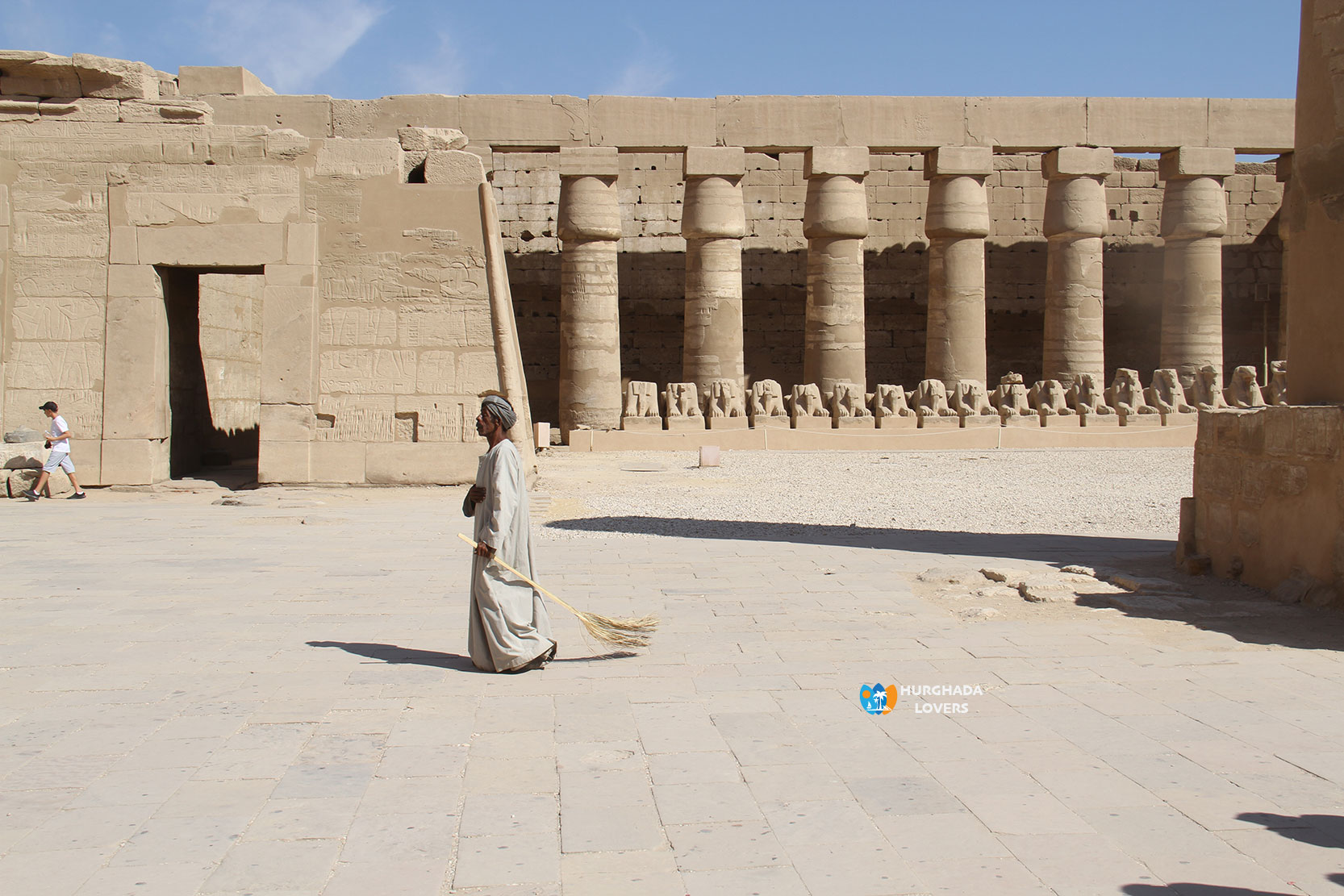
Solar alignment on Karnak Temple
A phenomenon occurs Perpendicularity Sun rays every year on December 21 on the Holy of Holies things, The same date as the birth of the god Amun. The most important religious symbols and beliefs of the ancient Egyptians.
Sound and Light Shows Karnak Temple:
Sound and light shows are currently being presented to tell the story of the construction and construction of the unique Karnak temples in more than one language (Arabic, English, French, German, Spanish, Italian, Japanese).).
Why is Karnak Temple so famous?
The Karnak Temple is considered one of the most famous temples ever in the city of Luxor and the whole world. It is dedicated to the worship of the gods Amun, Mut, and Khonsu, and it is considered the largest religious building ever built..
The temple was built during the Middle Kingdom era of the Pharaonic civilization. Then the kings of the New Kingdom of ancient Egypt expanded the temple and added small temples and tombs to it..
In the ancient Pharaonic era, it was believed that the city of Thebes was one of the first cities to be built on a primitive hill that was high above the ground. Then stood the God Atum or the god Ptah, as was believed in ancient times. In addition, it was considered a place for worshiping the god Amun and a place of special sanctity..
In the past, the kings of the Pharaohs used to fill Pylon with the remains of stones, just as King Horemheb did, as he filled the three Pylon with the remains of the stones of the Temple of Aten at Karnak after he demolished it, in addition to King Amenhotep III, who in turn filled his third Pylon with the stones of the chamber of King Senusret I..
The Karnak Temple Complex is considered one of the ritual temples, which are temples of traditional rituals and worship dedicated to one or more specific gods. In it, the usual daily rituals for that god are held, in which the dates of the king are written since he assumed the throne and his achievements, and the secrets of funerary beliefs in ancient Egypt are revealed to us..
Who built the Karnak Temple?
It includes the temple of the god (Amun), his wife (Mut), and their son (the god Khonsu), the god of the moon. Since the Arab conquest, Karnak has been known as the fort.
It begins with the path of rams, representing the god (Amun), which symbolizes the power of fertility and growth. Under its heads were carved statues of King Ramesses II..
To commemorate the memory of King Amenhotep III, he carved a statue of Memnon, and the height of the statue reaches 19 meters and a third of a meter.
The Greeks gave the name (The Colossi of Memnon) to them when the eastern statue of them cracked and produced a voice that they likened to the legendary hero (Memnon), who was mentioned in the Trojan Wars, and who used to call his mother. (Eos) the goddess of dawn, every morning, she would cry over him and her tears were dew.
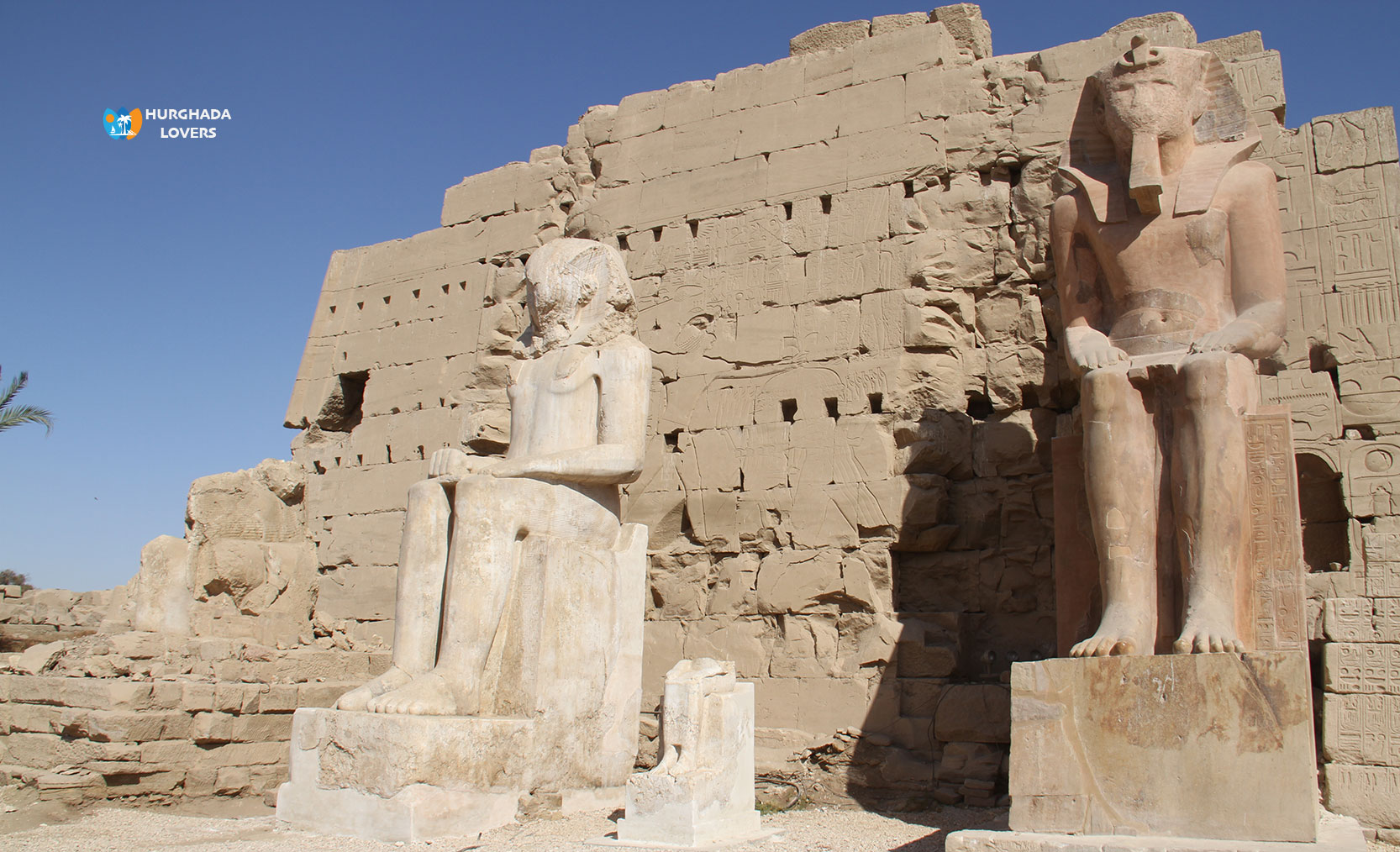
History of the construction of the Karnak temple complex
Middle State Stage
Kings rose Eleventh Dynasty Pharaonic By taking the land of the city of Karnak as a place to build the great temple, where until now you will find the white chapel of King Senusret I and the Central State Court inside the Karnak Temple, where King Senusret I built the temple from the period 1971 to 1926 BC, using limestone in the construction..
The Stage of the Modern Atate
The kings of the Eighteenth Dynasty were interested in developing Karnak Temple from the inside, especially after merging the worship of Amun with Ra, so that in the end Amun Ra became a god of war..
King Amenhotep I built the Temple of Amun Ra so that he could approach the priests, then King Thutmose I built the fourth and fifth Pylon, two obelisks of red granite, and built the Hypostyle Hall..
Then Queen Hatshepsut rose Months Queens of Egypt The Pharaohs throughout history built the eighth Pylon and built two obelisks reaching a length of 29 meters and constructing some small shrines.
Then King Thutmose III built the shrines and built a huge mud-brick wall around the obelisks of the Pharaohs belonging to Queen Hatshepsut..
The Pharaonic king Amenhotep III built the third pylon and the hypostyle hall, then King Akhenaten, who worshiped the sun disk furnace and built his own temple, but King Horemheb demolished it, so he built the second, ninth and tenth pylon..
What does Karnak mean? Etymology?
The ancient Egyptians called the Karnak Temple “Apet-Sut,” meaning “the seat of the thrones” in the ancient Egyptian language, considering that it was the temple of the god Amun, “the lord of the thrones of the two lands,” one of the most important religious beliefs and ancient Egyptian deities.
As for the name of Karnak, it may have come from (kar-success), meaning “The cabin of the goose called Najj,” which is known to symbolize the god Amun, who was said to have appeared in one of the creation myths of ancient Egypt in the form of a male goose that shouted the first call in existence. It is the greatest temple in the history of ancient Egypt.
Karnak means “chosen places” in ancient hieroglyphics, and was built around 2055 BC within the city of temples, dedicated to the worship of ancient Pharaonic gods..
The temple was named after the city of Karnak, which is taken from the corruption of the word Khorang, in other linguistic meanings, the fortified village.
The temples were named under the name of Bar Amun, meaning the Temple of Amun or the House of Amun. Then it was named in the era of the Middle Kingdom in ancient Egypt, the name Abet Sut, which linguistically means the most chosen or The chosen spot.
The Karnak Temple was given more than one name throughout the ages and the Pharaonic dynasty, beginning with the New Kingdom in ancient Egypt, such as Nesut-Toa, meaning the Throne of the Dolins, and Abit Iset, meaning the most magnificent residence. Egyptologists discovered these names on inscriptions and drawings found on the walls of King Senusret I’s cabin in The third pylon.
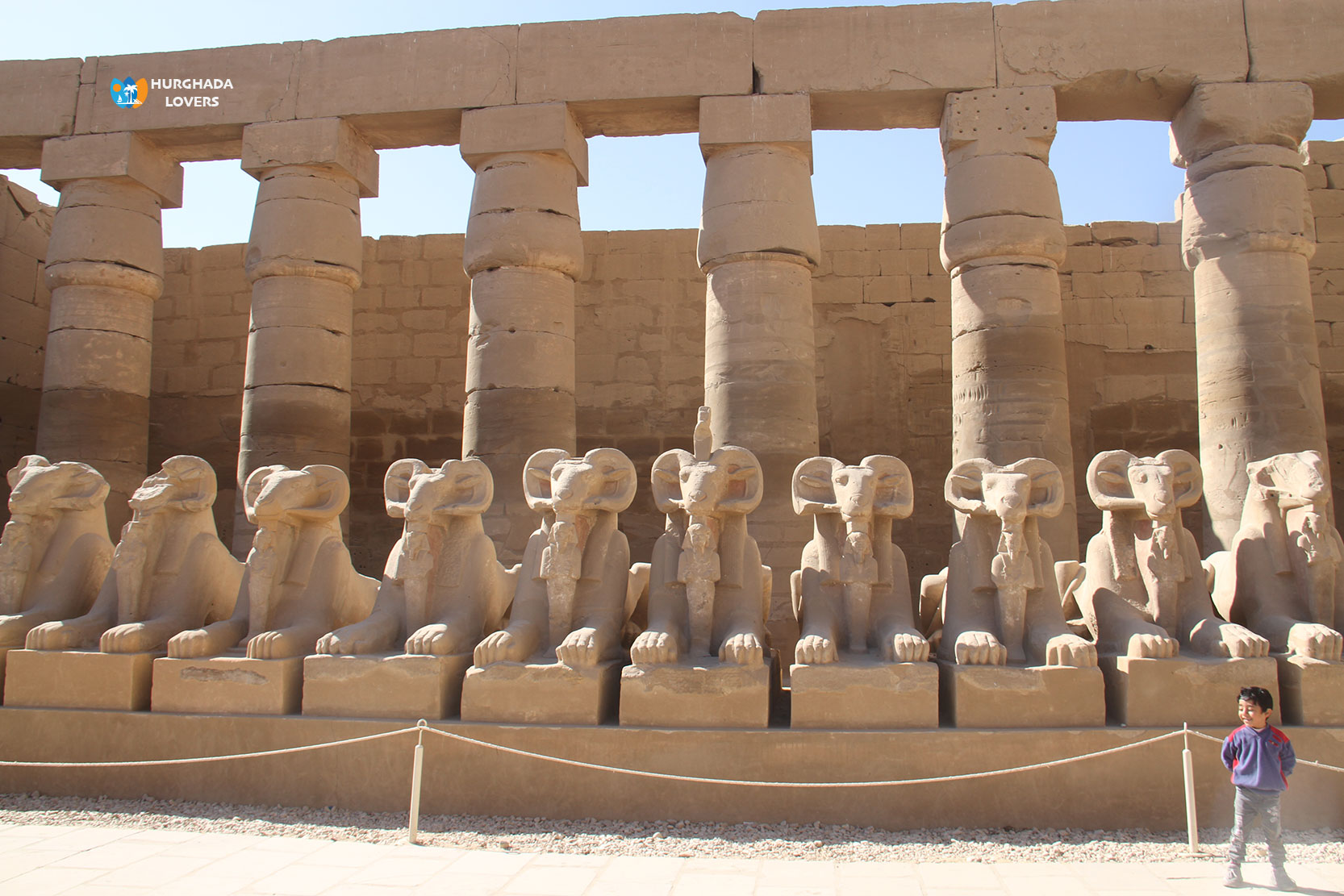
Karnak Temple Opening Hours:
Open daily from 07:00 AM to 05:00 PM.
Karnak Temple Location:
East bank of the Nile, north of Luxor Temple, Luxor, Egypt.
Karnak Temple Entrance Fee 2024:
Note: Ticket prices for foreign tourists will be increased starting next June at an increase rate of about 20% or more.
Foreigners:
Adults: 450 Egyptian pounds
Student/children from 6 to 10 years: 225 Egyptian pounds
Children under 6 years: free.
FAQ:
Is Karnak the largest temple in the world?
The Karnak Temple complex is considered one of the largest open-air temples and the largest religious complex in the world.
Are Karnak and Luxor temples similar?
The Karnak Temple complex differs from the Luxor Temple, as it contains many small temples, huge obelisks, and holy places, while the Luxor Temple is smaller in size and area..
It connects the Karnak Temple complex to the Luxor Temple via the Rams Road.
Opinion of the writer and researcher: Tamer Ahmed Abdel Fattah
- The Karnak Temple Complex needs 6-8 hours to be able to wander freely inside it, get to know and photograph the walls, and visit the inner temples. Therefore, Luxor Day Trips via one-day bus or minivan with a small group will give you only 60 minutes to tour inside only 20% of this open archaeological museum. Therefore, I advise you to stay in Luxor for 2-3 days and devote at least 6 hours to a temple, or book a private tour and control your time and be able to tour the temple for 150 minutes in addition to the program of visiting the rest of the temples and Pharaonic tombs.
- Follow the article continuously. The content will be updated describing the views and inscriptions on the walls of the temples, the columns of the Hypostyle Hall, and every point in the Karnak temple complex in detail, pictures, and videos.
Note: Facts and secrets of the history of Karnak Temple will be added soon…
Hurghada Excursions Lovers, Best Travel Agency in Hurghada to provide daily tours to visit the Tourist attractions of Luxor by Hurghada to Luxor Tours and Hurghada to Pyramids Trips. Book online when you come to Hurghada, El Gouna, Sahl Hashish, Makadi Bay, Soma Bay, Egypt.
